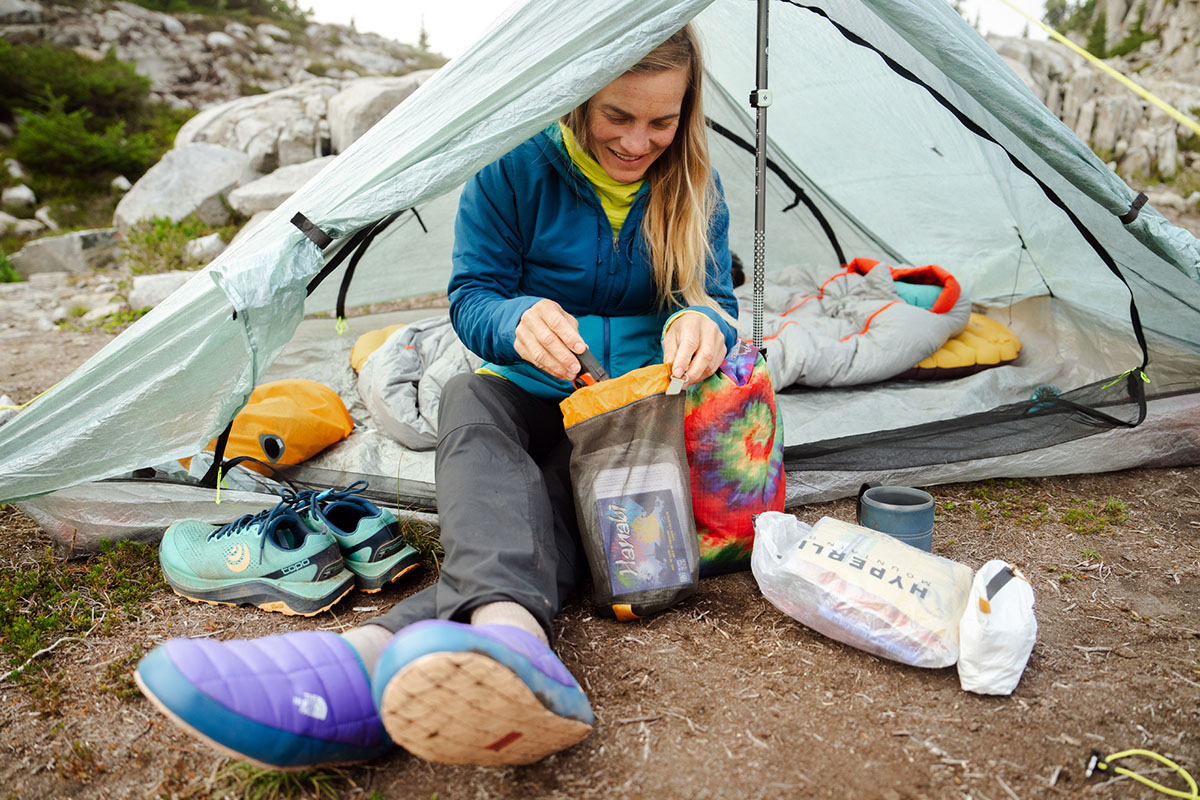
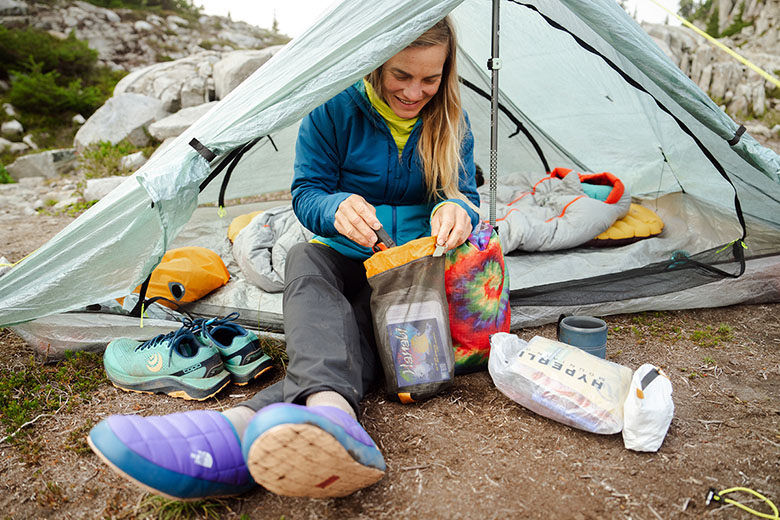
Switchback Travel (Jason Hummel)
Ah, the stuff sack. Perhaps no other piece of outdoor gear packs as much function into such a small and lightweight form. From organizing toiletries, food, or clothing to compressing your backpacking tent or sleeping bag and protecting items against moisture, stuff sacks are an invaluable addition to any gear list. To accommodate their various uses, stuff sacks come in a wide range of sizes, materials, and styles, from simple nylon ditty bags to ultralight compression sacks and waterproof roll-tops. Below we break down the best stuff sacks of 2024. For more information, see our stuff sack comparison table and buying advice below the picks.
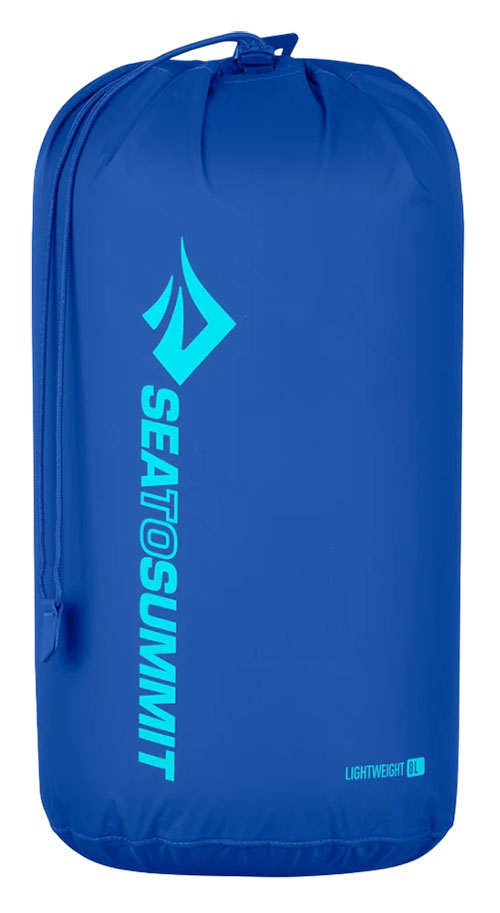 Capacities: 3, 5, 8, 13, 20, 30L
Capacities: 3, 5, 8, 13, 20, 30L
Closure: Drawstring
Material: 70D nylon
What we like: Durable materials, smooth operation, and premium features.
What we don’t: Pricier than budget offerings and a bit heavy.
Australia-based Sea to Summit dominates the stuff sack market with a full suite of designs ranging from simple nylon and mesh organizers to dry bags and compression sacks. Their Lightweight Stuff Sack is a high-quality all-rounder that will get the job done for most. Built with 70-denier nylon and featuring a PU lining and PFC-free DWR finish, the Lightweight is both durable and highly water-resistant, and the white interior helps eliminate the deep-dark-hole effect of many stuff sacks. We also love the smooth operation of the drawcord opening: The rubber pull-tab and cord-lock function make opening the bag a single-pull effort, rather than having to pull the drawcord and then pry open the fabric. To top it off, the Lightweight boasts a convenient webbing handle at the base and reinforced stitching throughout.
Why opt for the Sea to Summit Lightweight Stuff Sack over other options here? We think a drawcord is by far the most user-friendly opening, and the Sea to Summit’s is particularly durable and well executed. Many backpackers will also appreciate the water-resistant fabric, especially for storing items like clothing, electronics, or food (although keep in mind that without a roll-top closure or taped seams, the Lightweight is by no means waterproof). It’s true that you can save some money with a model like the REI Lightweight below (about $5 less, depending on size), but expect compromises in overall quality, user friendliness, and protection. All told, the Sea to Summit Lightweight is a solid workhorse stuff sack that feels more premium than most. If you’re looking to save weight, check out Sea to Summit’s Ultra-Sil Stuff Sack, which boasts a similar feature set but uses thinner 30-denier silnylon.
See the Sea to Summit Lightweight Stuff Sack
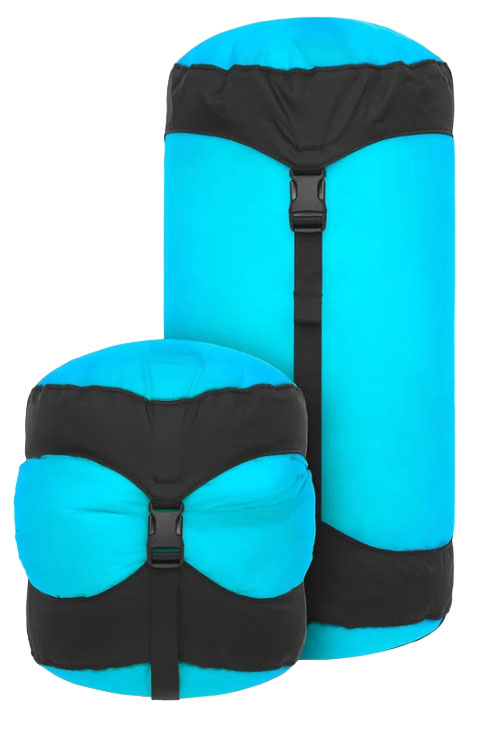 Capacities: 5, 8, 13, 20, 35L
Capacities: 5, 8, 13, 20, 35L
Closure: Compression (drawstring)
Material: 30D silnylon
What we like: Extremely easy to use thanks to the drawstring closure, attached lid, and side-release buckle.
What we don’t: Expensive and not waterproof.
If you're a fan of human-powered adventures, you know the importance of a well-packed kit, whether it's in your backpack, on a boat or sled, or affixed to a bike frame. When space is tight, the compression sack is an invaluable tool for stashing bulky items like a tent, sleeping bag, or clothing—if you’ve never used one, it’s truly remarkable how much they can streamline your load. The Sea to Summit Ultra-Sil Compression is our favorite design, with a simple drawstring closure (much easier to operate than a roll-top), a flip-top lid that stays attached for easy operation (most compression sack lids release from the top and end up dangling haphazardly while open), and a side-release buckle for quick access. Taken together, the design is both sleek and intuitive—more so than any other compression sack we've used.
The Ultra-Sil is Sea to Summit’s lightest compression design, which makes a lot of sense for most: If you’re opting for a space-saving stuff sack, chances are you care about weight, too. The 30-denier silnylon is made with Cordura fibers and impressively strong, and the DWR finish will keep light moisture at bay. However, keep in mind that the Ultra-Sil is not fully waterproof and should not be relied upon for protection in wet environments or conditions. For a more durable option, check out Sea to Summit's Lightweight Compression Sack, which offers the same set of convenient features for a slight weight penalty. And if you're looking for complete waterproof protection—which might be wise for your down sleeping bag and jacket—check out the Sea to Summit Evac series (we cover the Evac UL below).
See the Sea to Summit Ultra-Sil Compression Sack
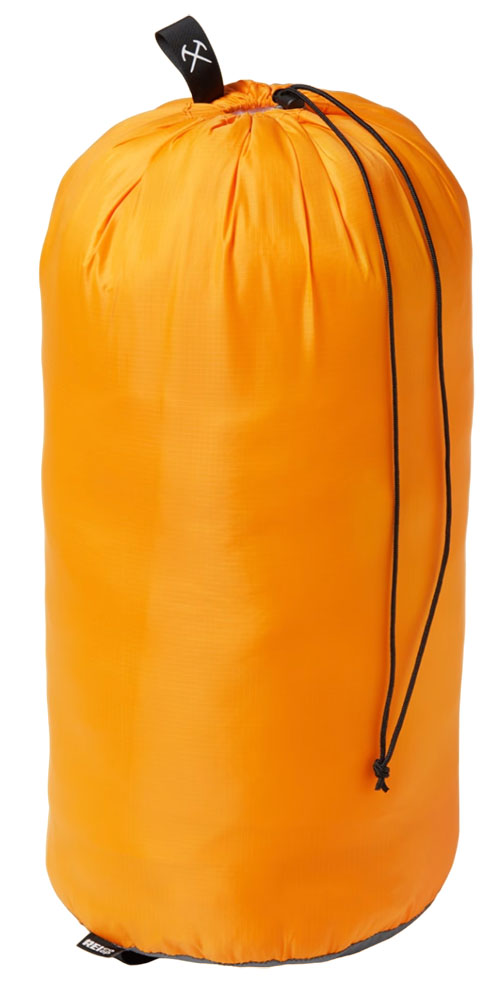 Capacities: 5, 10, 15, 20L
Capacities: 5, 10, 15, 20L
Closure: Drawstring
Material: Nylon
What we like: Cheap and lightweight.
What we don’t: Basic closure and not particularly water-resistant.
The Sea to Summit Lightweight above is an undeniably premium stuff sack, but not everyone needs the best that money can buy. If you’re in the market for a simple, no-frills design for occasional use, check out REI’s Lightweight. At around $5 less per sack than the Sea to Summit Lightweight above, the savings will certainly add up (especially if you purchase multiple sizes), and the REI bags are significantly lighter at around half the weight. Importantly, the ripstop nylon construction is still decently durable, and there's a DWR finish for fending off light moisture.
That said, if you’re someone who appreciates added bells and whistles, the REI does come up short. Unlike premium Sea to Summit offerings, the Lightweight forgoes a cord lock, so opening the stuff sack requires pulling on the cinch first before tugging open the bag’s mouth. It also lacks the Sea to Summit's white interior for added visibility and PU coating for improved protection against moisture. But if you just need a simple stuff sack for organization, the REI nevertheless is a low-priced yet serviceable option (it’s also available in a compression version for $22 to $27). Finally, it’s worth noting that purchasing sets of stuff sacks can also be a good way to save, including bundles like the BeeGreen Ditty Bags (six for $17) or REI’s Ditty Sacks (three for $20).
See the REI Co-op Lightweight Stuff Sack
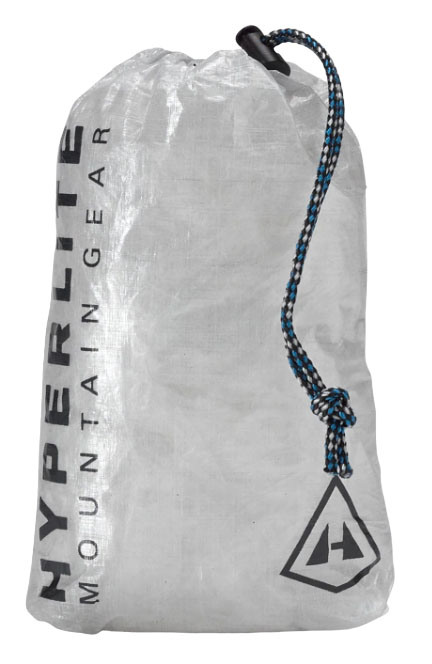 Capacities: 0.3, 2, 3, 4, 9, 13L
Capacities: 0.3, 2, 3, 4, 9, 13L
Closure: Drawstring
Material: Dyneema (0.8 or 1.3 oz/yd2)
What we like: Durability and water resistance at an impressively low weight; very high-end feel.
What we don’t: Expensive; flat shape gives it a less open interior.
Like most products from Hyperlite Mountain Gear, their stuff sacks are wildly premium and built with Dyneema, a pricey material lauded for its high tensile strength, low weight, and inherent waterproofing abilities. This is the kind of stuff sack you can throw around and take into wet weather with confidence (if you’re hard on your gear, it’ll last a whole lot longer than nylon alternatives). The drawstring sacks come in six sizes, and the shape is unique from most stuff sacks here—essentially, it’s just two pieces of material sandwiched together rather than the more standard cylindrical design. And Hyperlite offers the choice between two fabric weights (along with three colorway options), which is great news for serious ultralighters who like to have some control over the material and weight of their gear.
Not everyone will like the Hyperlite’s flat, angular shape, but we’ve found it to be a perfect fit for the slim external dump pockets of ultralight backpacks. The 4-liter version in particular is ideal for three days’ worth of dehydrated breakfasts and dinners, or a book and journal. The price tag is an undeniably tough pill to swallow, especially given that the bag's seams are simply laminated and not stitched, which could lead to some issues over time (although we haven't experienced any). But it really is hard to beat the lightweight durability of Dyneema—if you’re counting ounces, these stuff sacks are about half the weight of Sea to Summit’s lightest offering (the Ultra-Sil Stuff Sack)—and Hyperlite’s build quality and brand cachet are second to none. For a Dyneema design with a more standard cylindrical shape, check out the Zpacks Stuff Sack below.
See the Hyperlite Mountain Gear Drawstring Stuff Sack
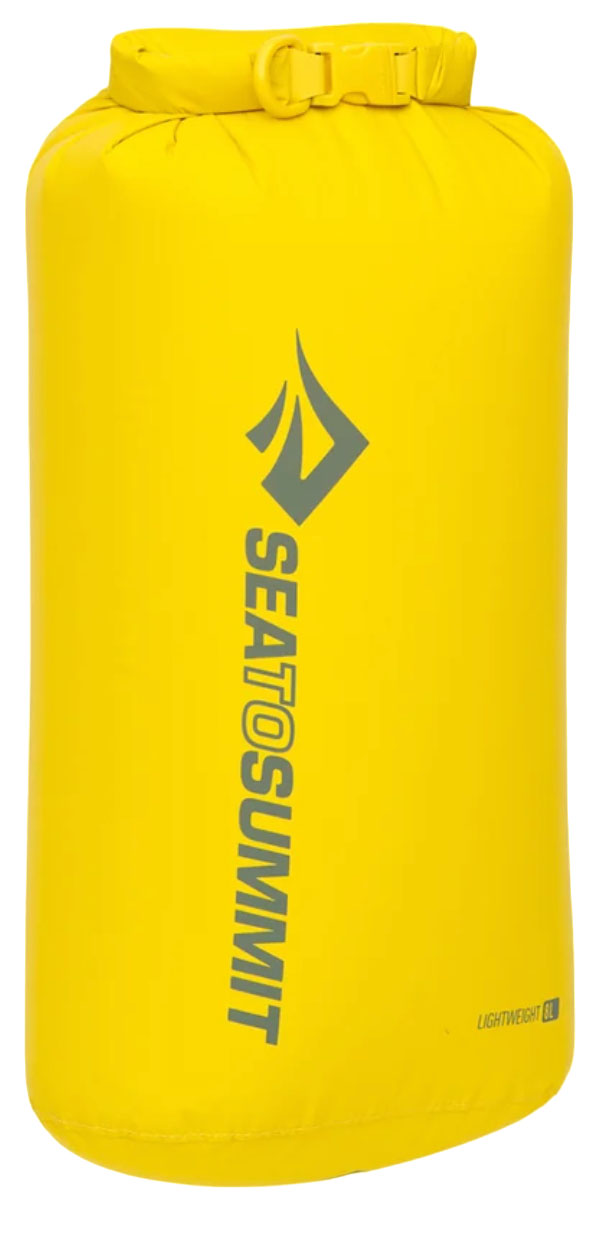 Capacities: 1.5, 3, 5, 8, 13, 20, 35L
Capacities: 1.5, 3, 5, 8, 13, 20, 35L
Closure: Roll-top
Material: 70D nylon
What we like: A waterproof take on our top pick.
What we don’t: Not as durable or lightweight as Dyneema.
Before we dive into the details, it's important to outline the waterproof stuff sack category as a whole. Essentially roll-top dry bags that feature waterproof materials and sealed seams, they're a great option for hiking through a rainforest or paddling up a fjord. However, these bags are by no means submersible, and many of the ultralight backpacking styles use very thin materials that are prone to abrasion—in other words, the "waterproof" designation does have some notable limitations. With all that in mind, let us introduce you to our favorite waterproof stuff sack: the Sea to Summit Lightweight Dry Bag.
The Lightweight Dry Bag is a waterproof version of our top pick (the Lightweight Stuff Sack), featuring the same materials but with taped seams and a roll-top closure. You can’t go wrong with any of Sea to Summit’s dry bag offerings, but the Lightweight Dry Bag strikes a particularly effective balance between weight and durability for all but the most discerning of ounce-counting backpackers, paddlers, and bikers. If durability is of greater concern than heft, Sea to Summit's Big River Dry Bag uses ultra-thick 420-denier nylon and a TPU lining (the 8L version checks in at 5.6 oz. compared to just 2.4 for the Lightweight Dry Bag in the same size). On the flip side, their Ultra-Sil Dry Bag clocks in at a scant 1.4 ounces for the 8-liter version but is much thinner and less durable. A final alternative is Hyperlite's Roll-Top Stuff Sack below, which is both lighter and more durable than the Sea to Summit but considerably pricier and realistically overkill for most.
See the Sea to Summit Lightweight Dry Bag
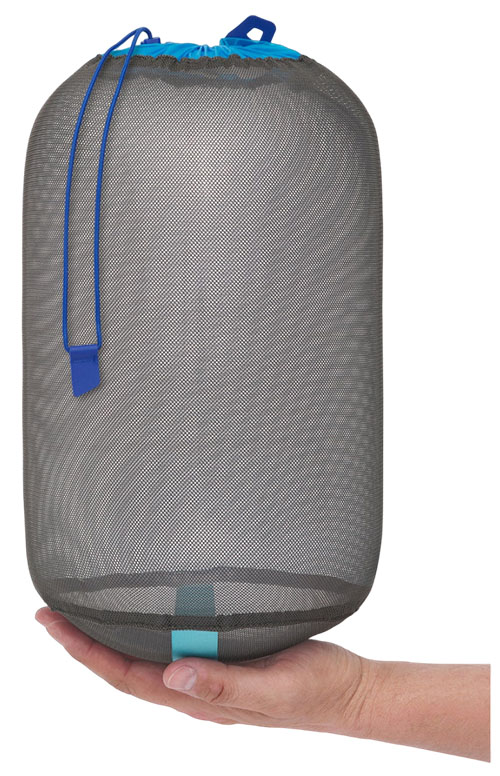 Capacities: 1.5, 3, 5, 8, 13, 20L
Capacities: 1.5, 3, 5, 8, 13, 20L
Closure: Drawstring
Material: 75D nylon mesh
What we like: Airy and breathable storage for sleeping bags, wet gear, food, and more.
What we don’t: Not as versatile as nylon designs.
If you haven’t yet noticed a theme among our top picks, perhaps at this point it will become clear: Sea to Summit dominates the outdoor storage space. They're also one of the only brands to offer a mesh stuff sack, which can be wildly useful for the right purposes. We love the breathable nature of their Mesh Stuff Sacks for long-term storage of soft gear like sleeping bags or insulation, and they function well for potentially wet items like a cook kit, swimming gear, or dirty clothes that need to air out. Heck, we even know someone who uses them for foraging mushrooms. No matter what you’re storing, the mesh design makes gear easy to find, doesn’t grow clammy inside, and drains quickly when wet.
Sea to Summit's Mesh Stuff Sack sticks to a similar script as their Lightweight Stuff Sack above, including a smooth-operating drawstring with a rubberized tab and cord lock at the top, plus a webbing handle at the base for easy grabbing. We’ve been using our mesh stuff sack consistently for about half a year, and it shows no signs of wear thanks to the thoughtful construction, reinforced stitching, and very strong 75-denier mesh. It's also a nice bonus that these mesh ditties are cheaper than most nylon alternatives, although most folks will likely want at least one water-resistant or waterproof stuff sack in their arsenal (the Mesh Stuff Sack is a nice supplementary bag). If you're curious about sizing, we particularly love the 20-liter version for sleeping bag storage or as a laundry bag, while the 5- or 8-liter models work well for organizing food during a backpacking trip.
See the Sea to Summit Mesh Stuff Sack
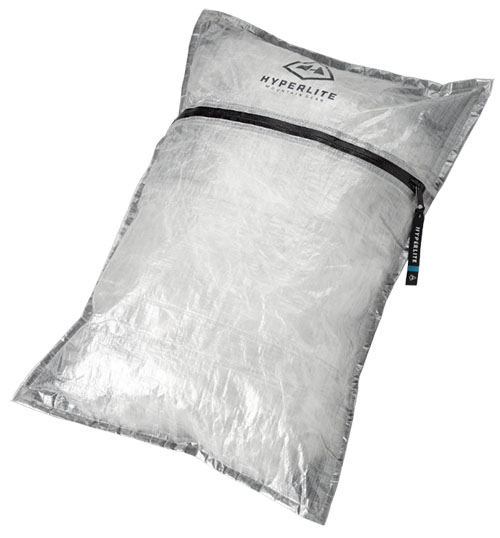 Dimensions: 12 x 17 in.
Dimensions: 12 x 17 in.
Closure: Zipper
Material: Dyneema (0.8 oz/yd2) & fleece
What we like: Dual-purpose design is extremely practical and convenient for streamlining your kit.
What we don’t: Pricier than Zpacks' stuff sack pillow; only offered in one size.
What a concept, the stuff sack pillow! Of course, you can make a pillow out of any old stuff sack, but Hyperlite’s purpose-built design really does up the game. With a reversible construction that features Dyneema on one side and soft fleece on the other, you get a waterproof stuff sack by day and a comfy pillow by night. To boost comfort, the sack also features a sleeping bag-friendly rectangular shape and an offset, water-resistant zipper that keeps everything secure and is positioned out of the way as you sleep.
Hyperlite currently offers the Stuff Sack Pillow in just one size, which has roughly a 5-liter capacity. In use, we've found it offers ample space for our extra socks, underwear, and baselayers but isn't big enough for stashing bulkier items like a sleeping bag. For alternatives, Zpacks—another ultralight Dyneema specialist—also makes a stuff sack pillow that comes in two sizes (5.6 and 8.2L), positions the zipper at one end, and tacks on a roll-top closure. We think the Hyperlite is overall the better design—the Zpacks' looks and feels a little less refined, and the dimensions are a bit long and skinny for our liking—although it's the pricier option of the two by a small margin. No matter the brand, we’re big fans of the dual utility of stuff sack pillows and have found them to be more comfortable than many inflatable backpacking pillows.
See the Hyperlite Mountain Gear Stuff Sack Pillow
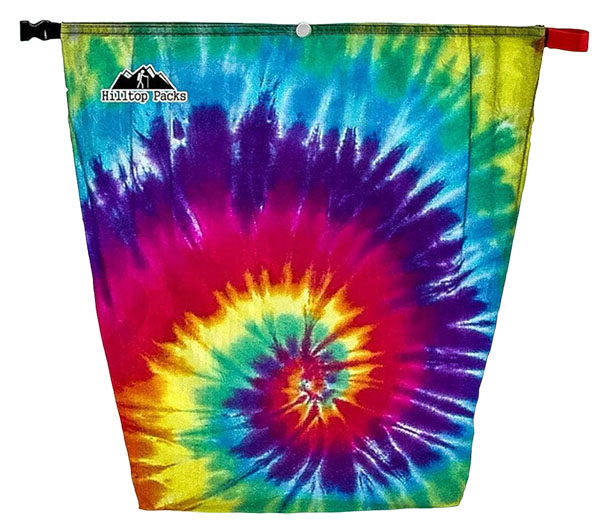 Capacities: 7-8L, 12-13L
Capacities: 7-8L, 12-13L
Closure: Roll-top
Material: Ecopak DTRS75 (polyester)
What we like: Purpose-built for food storage; fun patterns and the option for a spoon stash.
What we don’t: Expensive and not bear-resistant.
You can throw your backpacking food into any old stuff sack, but we’ve got a special place in our heart for Hilltop Packs’ Bear Bag. In short, there’s a lot to love about the Bear Bag, the most obvious of which is the option for fun patterns and custom-printed designs. The bag comes in two sizes (the smaller of which was a great match for a recent three-day backpacking trip), features a simple buckle and roll-top closure to accommodate everything from a full load to a dwindling supply, and gives you the option of adding a flat bottom for an extra $3 (totally worth it, in our opinion). But our favorite add-on feature is the spoon stash, a simple piece of additional mesh on the inside that ensures you’ll never lose your spoon or spork again.
Despite its name, the Hilltop Packs Bear Bag is not a true “bear bag”—i.e., it's not bear-proof or even bear-resistant—but does come with a reinforced loop for hanging (Hilltop also offers the bag as part of a hanging kit, which includes 50 ft. of line and their Rock Throw Bag). And it’s certainly durable enough to throw around, whether you opt for the Dyneema (1.43 oz/yd2) version or one of the two weights of Ecopak, a new-age recycled polyester fabric that’s both waterproof and incredibly hardwearing. The model we link to here is made with the thinner variation of Ecopak and feels like the kind of gear we’ll have forever. The price is undeniably high (you can save with the thicker and non-patterned Ecopak version, which starts at $39), but many avid outdoor-goers will be willing to spend up for the chance to add a bit of flair to their backpacking kit.
See the Hilltop Packs Bear Bag (Ecopak)
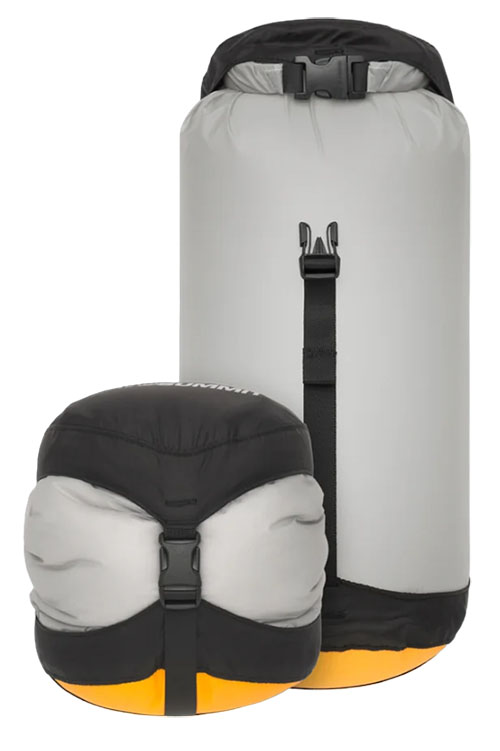 Capacities: 3, 5, 8, 13, 20L
Capacities: 3, 5, 8, 13, 20L
Closure: Compression (roll-top)
Material: 30D silnylon & eVent
What we like: A simple yet effective design that both compresses and protects—ideal for a down sleeping bag.
What we don’t: Expensive and fairly fragile.
It’s a stretch to call any stuff sack legendary, but the Sea to Summit Evac Compression has been around forever and certainly has achieved elevated status in our personal backpacking kit. The Evac not only gets your gear down to a small packed size, but also reliably protects belongings from moisture thanks to the fully waterproof construction. This combined performance is especially helpful for schlepping sensitive items like sleeping bags, down jackets, and clothing into wet areas. And there aren't a whole lot of trade-offs—the Evac is just 0.4 ounces heavier and $10 more than Sea to Summit's Ultra-Sil Compression Sack above for the 8-liter version (our preferred size for an ultralight sleeping bag).
Waterproof fabrics can sometimes make it difficult to purge extra air from a compression sack, but the Evac addresses this by using an air-permeable (but still fully waterproof) eVent fabric at the base. You also get a roll-top closure, along with a silicone-treated nylon body and taped seams. However, like the Lightweight Dry Bag above, the Evac is not submersible, and its 30-denier silnylon and eVent construction is also relatively fragile (Sea to Summit recommends against external use). But we’ve trusted the Evac to protect our down sleeping bag everywhere from the wet Coast Mountains in British Columbia to sopping conditions in the North Cascades, and it has yet to let us down. For added durability (and added weight), check out the standard Evac (70D) and Evac HD (420D). Finally, if you don’t need the waterproofing, we'd stick with the sleeker Ultra-Sil Compression Sack above, which is more user-friendly with a drawstring closure and attached lid.
See the Sea to Summit Evac Compression Dry Bag UL
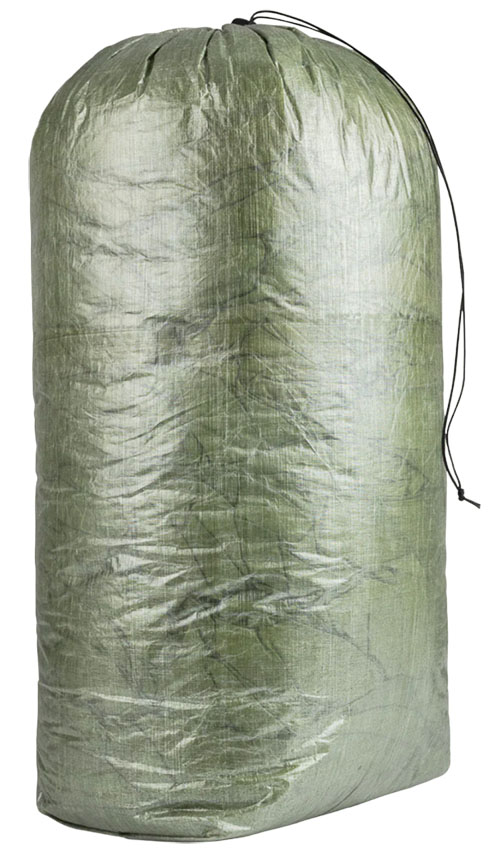 Capacities: 0.9, 1.7, 3, 4, 5.6, 8.5, 10.7, 12.3L
Capacities: 0.9, 1.7, 3, 4, 5.6, 8.5, 10.7, 12.3L
Closure: Drawstring
Material: Dyneema (0.55, 0.66, or 0.75 oz/yd2)
What we like: Offered in a range of sizes and fabric weights; features both sewn and taped seams for extra durability.
What we don’t: Has a homemade feel compared to more premium Hyperlite designs.
Hyperlite sits at the top of the Dyneema food chain, but Zpacks is another favorite among the UL crowd and stands out in a couple areas. Specifically, their designs are consistently cheaper than those from Hyperlite and come in a larger range of colorways, sizes, and variations. A case in point is their standard Stuff Sack, which is available in eight sizes ranging from 0.9 to 12.3 liters and checks in $10 to $20 cheaper than the corresponding Hyperlite bags. Zpacks also offers the option of choosing between three different thicknesses (0.55, 0.66, and 0.75 oz/yd2) to customize your sack’s durability and weight based on intended use: We like the thinner variety for stuff sacks that live predominantly inside a backpack, while the 0.75-ounce Dyneema is a great choice if you plan to hang your bag from a tree or schlep it around camp a fair bit.
In contrast to the laminated seams on Hyperlite's Drawstring Stuff Sacks, the Zpacks’ seams are both sewn and taped for added durability over the long term. We also like the cylindrical shape of the Zpacks, which accommodates bulky gear better than the Hyperlite’s flat, angular design. But unlike the Hyperlite, you can’t find the Zpacks in a thicker 1.3-ounce variety, and their stuff sacks do have a significantly more homemade feel—it’s common to see uneven stitching and loose threads. And if you’re looking for a roll-top closure, Zpacks’ Dry Bags come in nine sizes from 2.2 to 14 liters and are built with durable 1.0-ounce Dyneema (the two largest bags are “Food Bags” that use thicker 1.6 oz/yd2 Dyneema).
See the Zpacks Stuff Sack
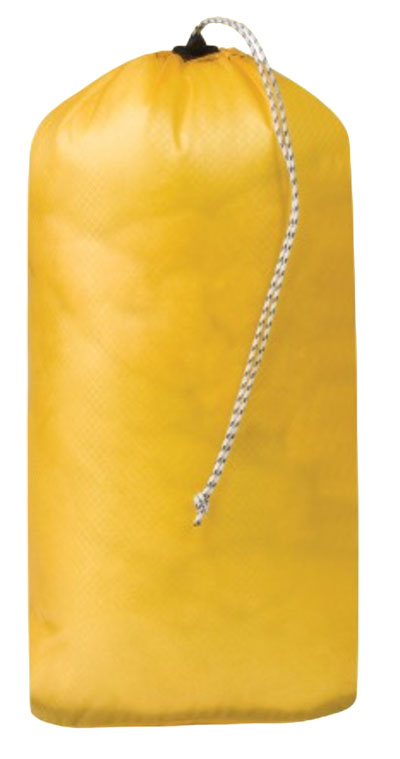 Capacities: 2, 3, 5, 11, 16L
Capacities: 2, 3, 5, 11, 16L
Closure: Drawstring
Material: 30D silnylon
What we like: No-frills stuff sacks that are both affordable and ultralight.
What we don’t: Not particularly durable.
Based in the Boundary Waters between Minnesota and Ontario, Granite Gear specializes in backpacking and portage packs and storage solutions. Their collection of stuff sacks includes everything from drawstring and compression sacks to waterproof and zippered designs, with the Air Bags here representing their bread and butter. While fairly standard in appearance, these stuff sacks are highlighted by their low weight—the 11-liter version is about half the weight of the 8-liter Sea to Summit Lightweight above—and the 30-denier silnylon is so thin you can see through it, which can help with locating items inside. If you’re looking to pick up some stuff sacks without adding too much weight to your load, Granite Gear’s are worth a look.
Another reason to reach for the Air Bags is their low price—and opting for a two- or three-pack can save you even more cash (at the time of publishing, the 5L is around $9 on its own or $21 for three). They’re also packaged in a zippered sack, so you’re effectively getting two storage solutions in one, although it’s a waste of materials if you don't end up using the extra piece. The thin silnylon isn’t particularly durable, and we haven’t been blown away by Granite Gear’s build quality—our Air Bag has some messy stitching, and you don’t get the cord-lock design we see on Sea to Summit’s bags—but they’ll get the job done for light use, especially if your stuff sacks spend most of their time in a backpack. And while we’re on the topic of Granite Gear, it’s also worth checking out their eVent Sil Compression DrySack, which is a low-cost alternative to the Sea to Summit Evac UL above.
See the Granite Gear Air Bag
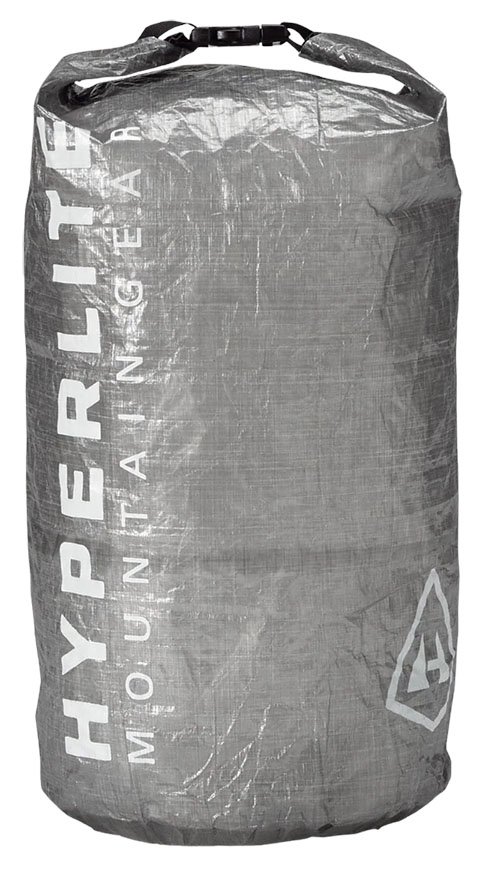 Capacities: 3, 10, 25, 43L (also available in 8, 10, 12, 15L Side Entry Pods)
Capacities: 3, 10, 25, 43L (also available in 8, 10, 12, 15L Side Entry Pods)
Closure: Roll-top
Material: Dyneema (1.3 oz/yd2)
What we like: Durability and waterproofing at an impressively low weight.
What we don’t: Expensive and limited capacities (although the largely similar Side Entry Pods fill the gaps).
The Sea to Summit Lightweight Dry Bag above is our favorite waterproof stuff sack, but Hyperlite Mountain Gear offers an intriguing and more premium alternative in their Roll-Top Stuff Sack. Built with Dyneema, the Hyperlite checks in around half the weight of the Lightweight with a completely waterproof (although not submersible) and even more durable construction. The collection comes in four sizes: Most backpackers will opt for the 10-liter version for their ultralight sleeping bag or clothing, the 3-liter sack is a great match for keeping a puffy jacket or valuables safe and dry, and the larger capacities are well suited for paddling trips and use outside of a backpack. All told, these bags are about as premium as they come for those willing to pay the price.
From Hyperlite’s lineup, we also love their Side Entry Pods, which come in 8, 10, 12, and 15-liter capacities and are shaped to match the contours of a backpacking pack. The two designs are largely similar: Both the Roll-Top Stuff Sacks and Side Entry Pods are built with hardwearing 1.3-ounce Dyneema, feature sewn seams that are also taped, and include a piece of rigid plastic that makes rolling the top a breeze. Neither design comes with a sling attachment (something you get with the Sea to Summit Lightweight), although the roll-top closure on the model here makes for a nice handle when closed. Again, Hyperlite gear—and Dyneema gear in general—doesn't come cheap, but the high-end construction should last a very long time.
See the Hyperlite Mountain Gear Roll-Top Stuff Sack
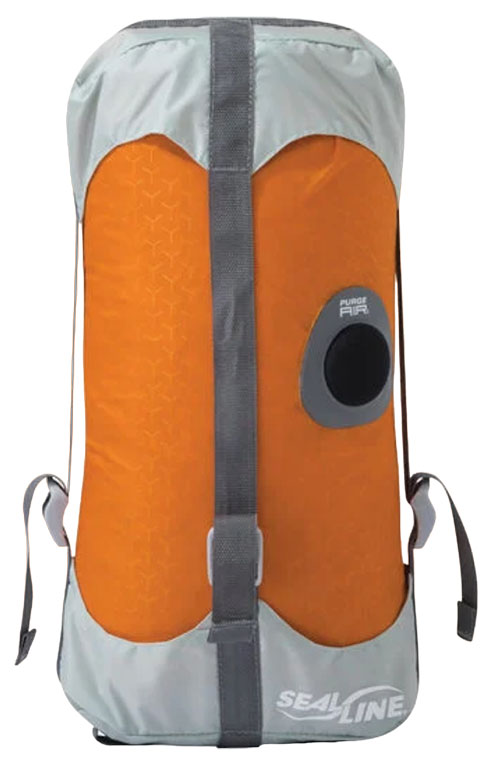 Capacities: 5, 10, 20, 30L
Capacities: 5, 10, 20, 30L
Closure: Compression (roll-top)
Material: 70D nylon
What we like: More durable and reliably waterproof than the Sea to Summit Evac above.
What we don’t: A bit bulky and heavy.
Sea to Summit’s Evac above is our favorite waterproof compression sack, but the SealLine Blocker is another strong option and gets the edge in a couple areas. In this case, SealLine opted for a thicker (70D) PU-coated nylon with a valve (dubbed "PurgeAir") for releasing excess air to minimize packed size. Although clunkier than the Sea to Summit, the Blocker is still very easy to operate: Simply press the contents of the sack down, and the valve will automatically vent excess air. Because of its durable construction, the SealLine is also the better option for use outside of a pack—think paddling or bikepacking trips when your gear will be exposed to the elements.
SealLine’s marketing takes direct aim at the Sea to Summit Evac, stating that the Blocker is more reliably waterproof than compression sacks with breathable membranes like eVent. We haven’t noticed a difference in performance while backpacking (even in very wet conditions) but would certainly be more likely to reach for the SealLine for environments where submersion was a possibility—30-denier silnylon and eVent is simply no match for the Blocker’s 70-denier PU-coated nylon. However, because of its somewhat bulky and heavy design, the Blocker is far from our first choice for activities in moderate climates or when we don't anticipate needing total waterproofing (which is realistically most of the time). Ultralight hikers can save weight and space with the BlockerLite Compression Dry Sack (which features 20D sil/PU nylon), but expect trade-offs in durability.
See the SealLine Blocker Compression Dry Sack
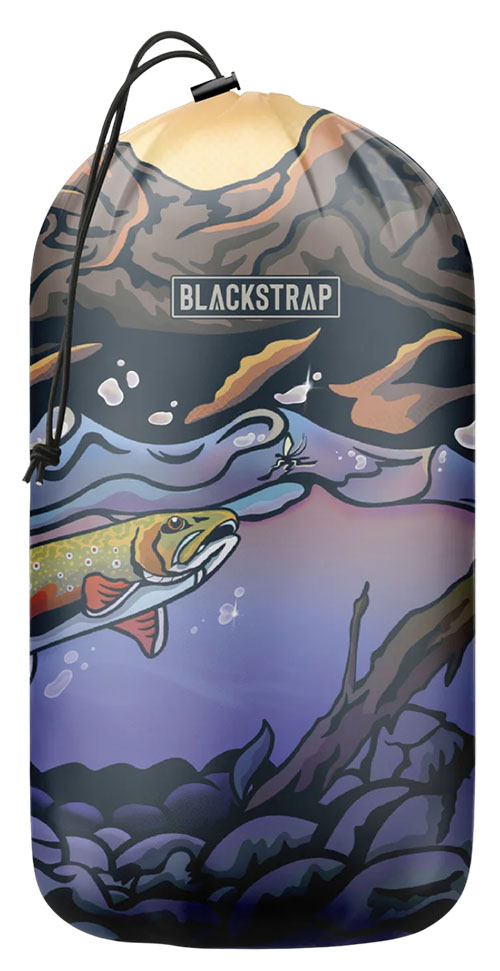 Capacities: 2, 7, 12L
Capacities: 2, 7, 12L
Closure: Drawstring
Material: Knit synthetic
What we like: A playful alternative to traditional stuff sacks; stretchy and breathable material comes in handy for certain uses.
What we don’t: Not very resistant to moisture.
Now for something a little different. Blackstrap got their start making stylish balaclavas and neck warmers for skiing and winter wear, most of which feature playful, patterned fabrics. In an effort to repurpose the scraps, the Bend, Ore., company also offers a full lineup of drawstring stuff sacks, available in 2-, 7-, and 12-liter varieties. These colorful ditty bags offer a fun alternative to the standard techy offerings that dominate the market, and the breathable, four-way stretch material can be a boon for certain uses.
We picked up a 2-liter Blackstrap Stuff Sack and immediately put it to use as our backcountry bathroom kit. Built to handle all manner of body odor and moisture in its role as a neck warmer, the air-permeable and wicking fabric keeps the interior of the bag fresh and stink-free—a lot more than we can say for clammier nylon and polyester stuff sacks. It’s true that the drawstring closure isn’t particularly smooth-operating, and you don’t get much (or really anything) in the way of moisture protection with the ultra-breathable design. But for the right application, there’s a lot to like about the fun and unique Blackstrap.
See the Blackstrap Stuff Sack
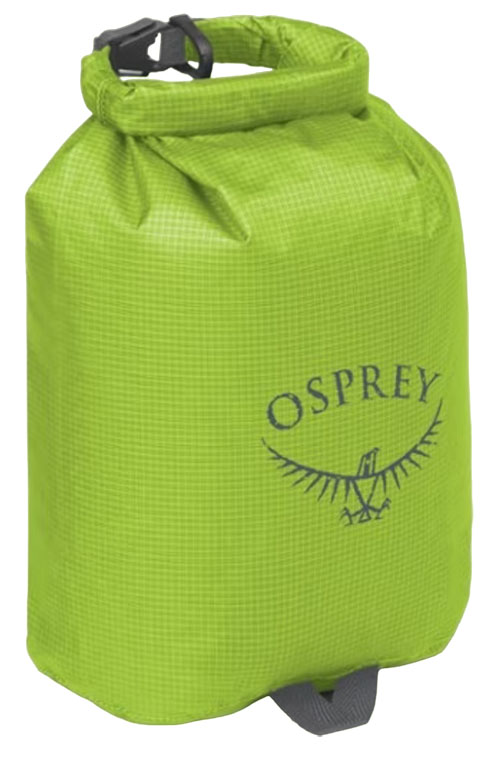 Capacities: 3, 6, 12, 20, 35L
Capacities: 3, 6, 12, 20, 35L
Closure: Roll-top
Material: 40D nylon
What we like: An inexpensive and decently reliable roll-top design.
What we don’t: Waterproofing can fail in extremely wet conditions.
Best known for their extensive selection of day-hiking and backpacking packs, Osprey also offers a number of packing solutions, including the Ultralight Dry Sack here. With coated 40-denier nylon, sealed seams, and a secure roll-top closure, the Ultralight Dry Sack is designed to protect against light moisture such as dew, mist, or rain drops that make it past the walls of a backpack. Osprey even gives it an IPX5 rating, which means it can handle short downpours or getting dropped in a stream. That said, as with all the stuff sacks on this list, the Dry Sack is not intended for submersion or consistent exposure.
Although roll-top designs like the Osprey (and even Dyneema options from Hyperlite and Zpacks) aren’t waterproof enough to be submersible, there are still several reasons you might want the added bit of water protection. For instance, we've used the 3-liter sack to house our first aid kit for years, and it's provided ample assurance for the sensitive items. Osprey also makes the Dry Sack with a see-through window, which is a great addition if you want to keep track of the contents inside. The nylon construction can’t handle nearly the same wear and tear as Dyneema, and Sea to Summit’s dry bag designs are decidedly more premium, but the Osprey’s price savings will be worth those trade-offs to some.
See the Osprey Ultralight Dry Sack
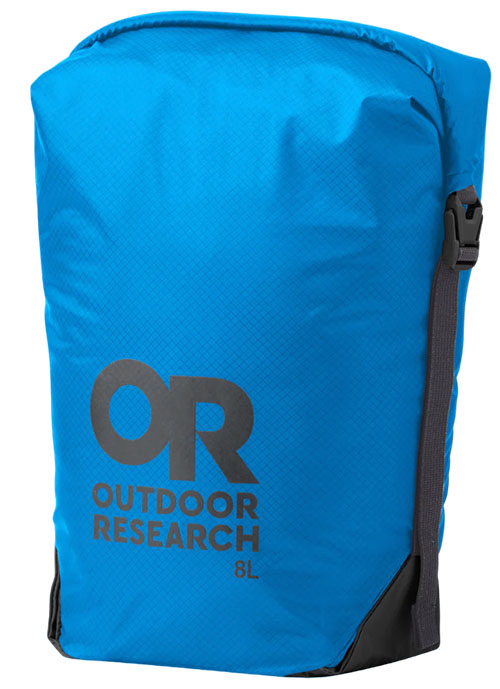 Capacities: 5, 8, 10, 15, 20L
Capacities: 5, 8, 10, 15, 20L
Closure: Compression (roll-top)
Material: 40D nylon
What we like: A sleek take on the compression sack design.
What we don’t: Takes some coordination to roll and secure shut.
Like many of the brands listed here, Outdoor Research doesn’t specialize in packing solutions—insulation and winter accessories are a couple of their strong suits—but does offer a number of competitive designs. Their PackOut Compression Stuff Sack here is unique in that it rolls and compresses using the same two straps—no need for finagling a cover. Overall, it’s a simple and streamlined design, although not perfect by any means: Unlike most compression sacks, you’ll have to undo both buckles before rolling and then secure them again once the bag is compressed—an extra step that requires a certain level of coordination to get everything locked down tight.
As with most nylon stuff sacks, the PackOut features a PU coating to keep water at bay, although it's still only moderately water-resistant. The same is true of all of OR’s stuff sack offerings, which also include an Ultralight Stuff Sack, PackOut Graphic Stuff Sack (both of which come in 5, 10, 15, 20, and 35L versions), and a unique two-sided Clean/Dirty bag (available in 10, 15, and 20L sizes). We’ve got to hand it to OR for coming up with some fun designs, though, which is a big selling point of their PackOut Graphic Stuff Sack.
See the OR PackOut Compression Stuff Sack
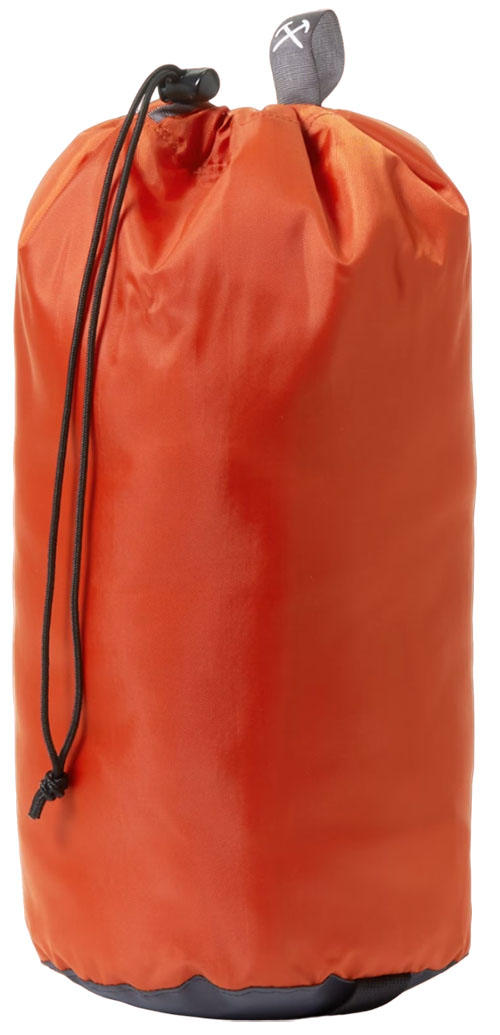 Capacities: 10, 15, 20, 30, 60L
Capacities: 10, 15, 20, 30, 60L
Closure: Drawstring
Material: Polyester
What we like: An affordable and durable stuff sack that comes in larger sizes.
What we don’t: Thick polyester construction feels dated and makes it hard to cinch the drawstring closure.
Despite their thin construction, even the lightest stuff sacks here will be durable enough for most people and uses. In fact, we’ve used and abused stuff sacks for over 30 years and have yet to put a hole in one without a pretty good reason (hanging them from our climbing harness has been a reliable way to cause damage). But if you know you’ll be subjecting your stuff sack to some hard use—perhaps it serves as a food-hanging bag or storage for camping gear—REI Co-op’s Durable is a great option. For stashing smaller items, their Ditty Sacks ($20 for a set that includes 2, 3, and 7-liter sizes) are made from the same hardwearing fabric.
In contrast to REI's Lightweight Stuff Sack above, which is made with relatively thin nylon, the Durable uses thick polyester that's reminiscent of outdoor gear from the 90’s—it’s overbuilt, crinkly, and even comes in the dated colorways you’d expect. The low price is certainly a selling point (even the biggest 60L capacity is cheaper than the smallest Sea to Summit Lightweight Stuff Sack), but not enough for us to recommend it over most designs here. And quality is a notable compromise with the budget pricing: We've found the drawstring closure to be particularly sticky, and the fabric is so thick that it's nearly impossible to get a good seal. These downsides are enough to push the Durable Stuff Sack to the bottom of our list, but it's cheap and will last a long time, which is never a bad combination.
See the REI Co-op Durable Stuff Sack
| Stuff Sack | Price | Capacities | Closure | Material | Weight | WP* |
|---|---|---|---|---|---|---|
| S2S Lightweight Stuff Sack | $17-24 | 3, 5, 8, 13, 20, 30L | Drawstring | 70D nylon | 1.7 oz. (8L) | N |
| S2S Ultra-Sil Compression | $35-53 | 5, 8, 13, 20, 35L | Compression | 30D silnylon | 2.3 oz. (8L) | N |
| REI Co-op Lightweight | $13-16 | 5, 10, 15, 20L | Drawstring | Nylon | 0.9 oz. (10L) | N |
| Hyperlite Drawstring | $29-55 | 0.3, 2, 3, 4, 9, 13L | Drawstring | DCF (0.8/1.3 oz.) | 0.5 oz. (9L) | N |
| S2S Lightweight Dry Bag | $18-35 | 1.5, 3, 5, 8, 13, 20, 35L | Roll-top | 70D nylon | 2.4 oz. (8L) | Y |
| S2S Mesh Stuff Sack | $13-20 | 1.5, 3, 5, 8, 13, 20L | Drawstring | 75D nylon mesh | 1.6 oz. (8L) | N |
| Hyperlite Stuff Sack Pillow | $59 | 12 x 17 in. | Zipper | DCF (0.8 oz.) | 1.7 oz. | Y |
| Hilltop Packs Bear Bag | $56-68 | 7-8L, 12-13L | Roll-top | Ecopak DTRS75 | 1.3 oz. (7-8L) | N |
| Sea to Summit Evac UL | $40-60 | 3, 5, 8, 13, 20L | Compression | 30D silnylon & eVent | 2.7 oz. (8L) | Y |
| Zpacks Stuff Sack | $19-35 | 0.9, 1.7, 3, 4, 5.6, 8.5, 10.7, 12.3L | Drawstring | DCF (.55/.66/.75 oz.) | 0.3 oz. (8.5L) | N |
| Granite Gear Air Bag | $12-20 | 2, 3, 5, 11, 16L | Drawstring | 30D silnylon | 0.9 oz. (11L) | N |
| Hyperlite Roll-Top | $49-79 | 3, 10, 25, 43L | Roll-top | DCF (1.3 oz.) | 1.2 oz. (10L) | Y |
| SealLine Blocker | $37-55 | 5, 10, 20, 30L | Compression | 70D nylon | 4.4 oz. (10L) | Y |
| Blackstrap Stuff Sack | $13-20 | 2, 7, 12L | Drawstring | Knit synthetic | Unavailable | N |
| Osprey Ultralight Dry Sack | $18-34 | 3, 6, 12, 20, 35L | Roll-top | 40D nylon | 1.2 oz. (6L) | Y |
| OR PackOut Compression | $25-37 | 5, 8, 10, 15, 20L | Compression | 40D nylon | 1.6 oz. (8L) | N |
| REI Co-op Durable | $11-15 | 10, 15, 20, 30, 60L | Drawstring | Polyester | 2 oz. (10L) | N |
*Editor's note: "WP" denotes waterproof, although none of the designs on our list are fully submersible.
Before purchasing a stuff sack, you’ll want to have a pretty good idea of its end use. Capacity might be the most straightforward decision, but perhaps even more important is its closure system and level of water resistance. To start, we break down the various types of stuff sacks below based primarily on their closure style. These include drawstring sacks, roll-top dry bags, compression sacks, and zippered designs.
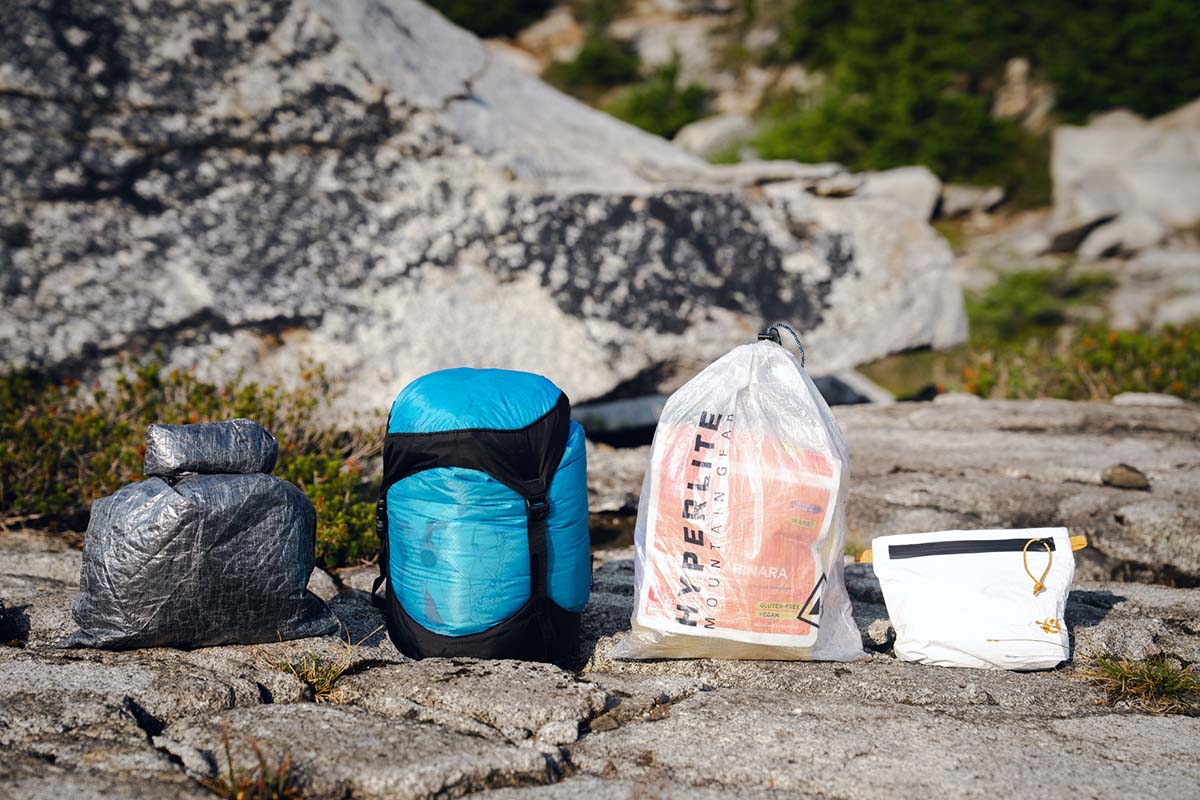
Drawstring
If you picture a traditional stuff sack, a drawstring closure likely comes to mind. Drawstring stuff sacks offer the best simplicity and ease of access, and they're generally the lightest and most packable, too. They’re our first choice for separating small items in our backpacking pack (we have one for hygiene, one for electronics, and one for on-trail essentials) and get the job done for simple storage of bulkier items, as well. The biggest downside to drawstring stuff sacks is that they offer no way to compress their contents, which can be especially helpful for lofty down jackets, sleeping bags, and even tents.
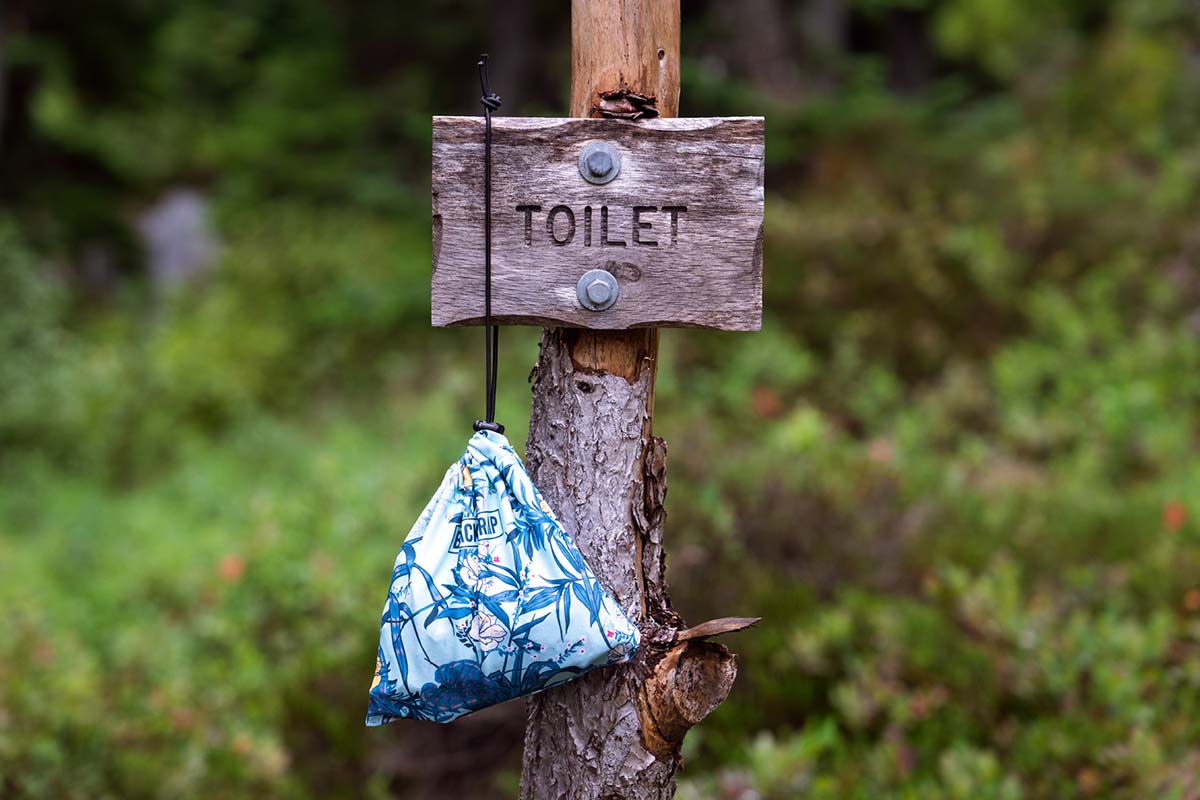
In terms of drawstring construction, we love Sea to Summit’s cord-lock design, which attaches the cinch to the collar so that the drawstring and sack open in one simple pull (with a simpler closure, you’ll have to first release the drawstring cinch, and then pry open the fabric). Most modern stuff sacks now forgo a flap underneath the top closure, but high-end offerings do a great job cinching tight to eliminate a gap through which water or debris might enter. And you'll want to watch out for budget designs (like the REI Co-op Durable), which can take some effort to open and close and don’t create a tight seal at the top.
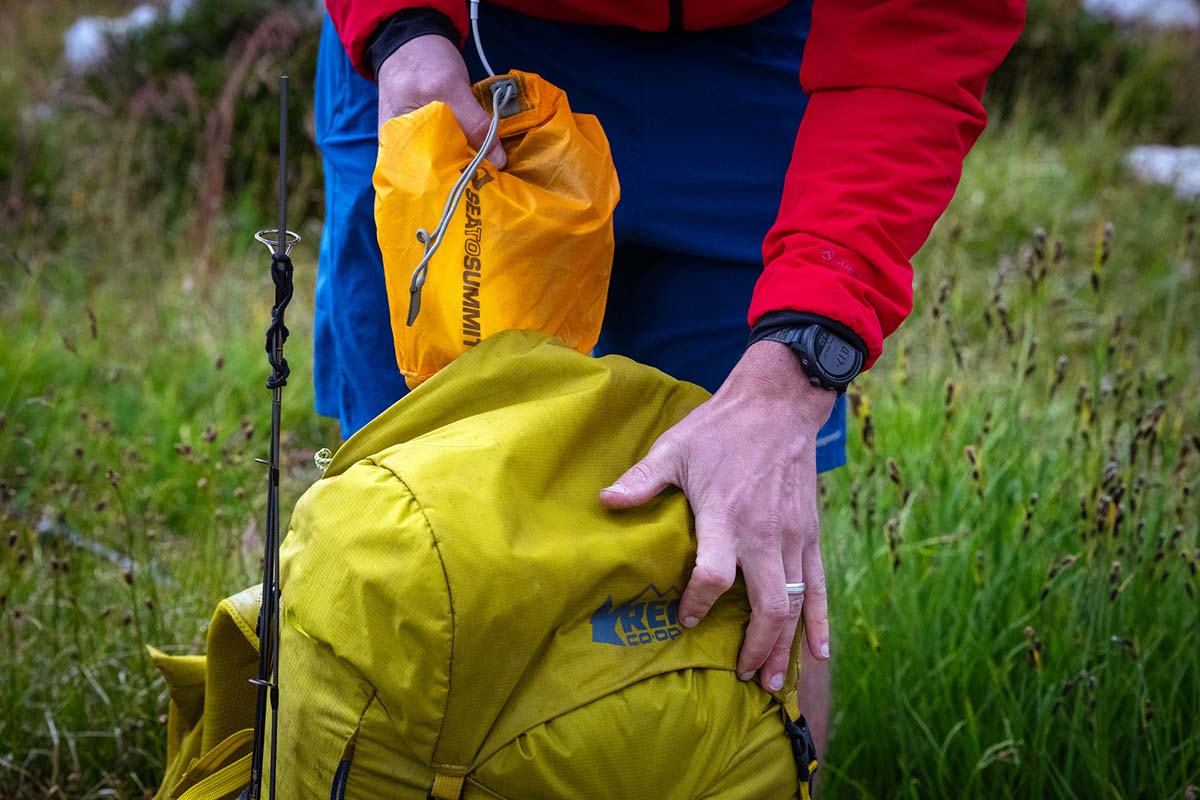
Roll-Top
Roll-top stuff sacks are the next step up from drawstring designs in terms of performance characteristics. Instead of a drawstring cinch, these sacks close by rolling the two sides of fabric together at the top and buckling them secure. Roll-top stuff sacks are more water-resistant than drawstring designs (most of them tack on sealed seams to complement the water-resistant closure), and they eliminate the superfluous material you get with a half-full stuff sack. Their closure also creates a nice handle at the top, which can be great for carrying around camp. Sea to Summit even makes a Dry Bag Sling for carrying your bag tote-style.
If moisture is a concern or you want the versatility to accommodate loads of various sizes, there’s a lot to like about roll-top stuff sacks. They’re also a nice middle ground between drawstring-equipped options and compression designs—you can purge a lot of air just by pressing while you roll (if the seams are taped, you’ll need to press first, and then roll). It’s important to note, however, that most roll-top stuff sacks—even those labeled as dry bags—are not completely waterproof. Even leading brands like Hyperlite and Sea to Summit recommend against submersion for their dry bags due to the lack of a watertight seal at the closure. But for heavy rain and damp environments, they can certainly get the job done.
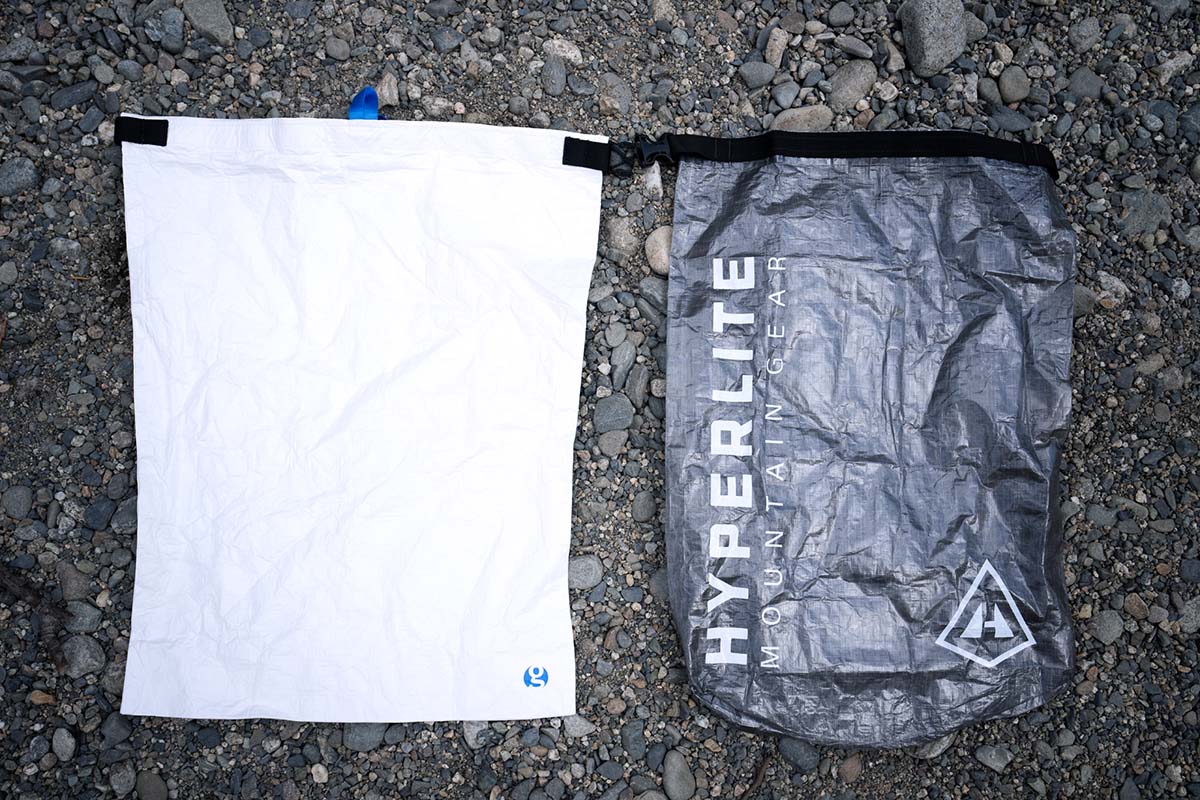
Compression
Next up are compression sacks, which are designed for space savings when packing bulky items like lofty down jackets, sleeping bags, tents, and more. It’s truly remarkable how well these little pieces of gear work—in some cases, they can compress their contents by as much as two thirds. Most compression sacks feature a drawstring closure; once closed, you place the lid overtop and cinch down the side straps to squeeze out extra air inside (note: it's important to not wrench too hard on the straps to overly stress or tear the stitching). Our favorite designs (like the Sea to Summit Ultra-Sil Compression Sack) feature a flip-top lid that stays attached for easy operation, which is a lot more convenient than lids that release all the way from the top and end up dangling haphazardly while open. We also appreciate sacks with at least one side-release buckle so you can easily free the lid to access your gear.
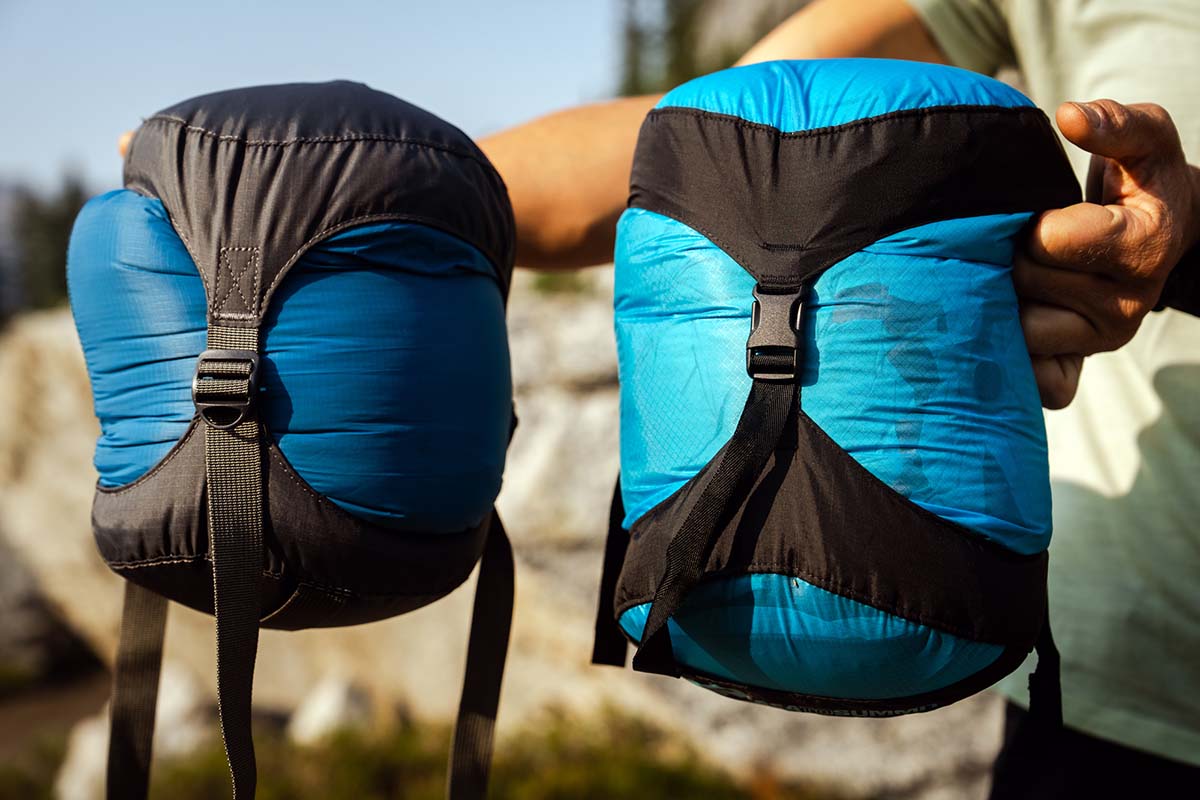
Waterproof designs are a bit tricky due to their taped seams, roll-top closures, and coated fabrics that don't easily let air escape when compressing the sack. To solve this issue, manufacturers have employed a few different strategies to balance waterproofing and air permeability. Sea to Summit’s Evac Compression Dry Bag UL, for example, purges air with a waterproof/breathable eVent fabric at the base. On the other hand, the SealLine Blocker features a one-way valve that opens when you apply pressure to the bag, releasing air as you roll.
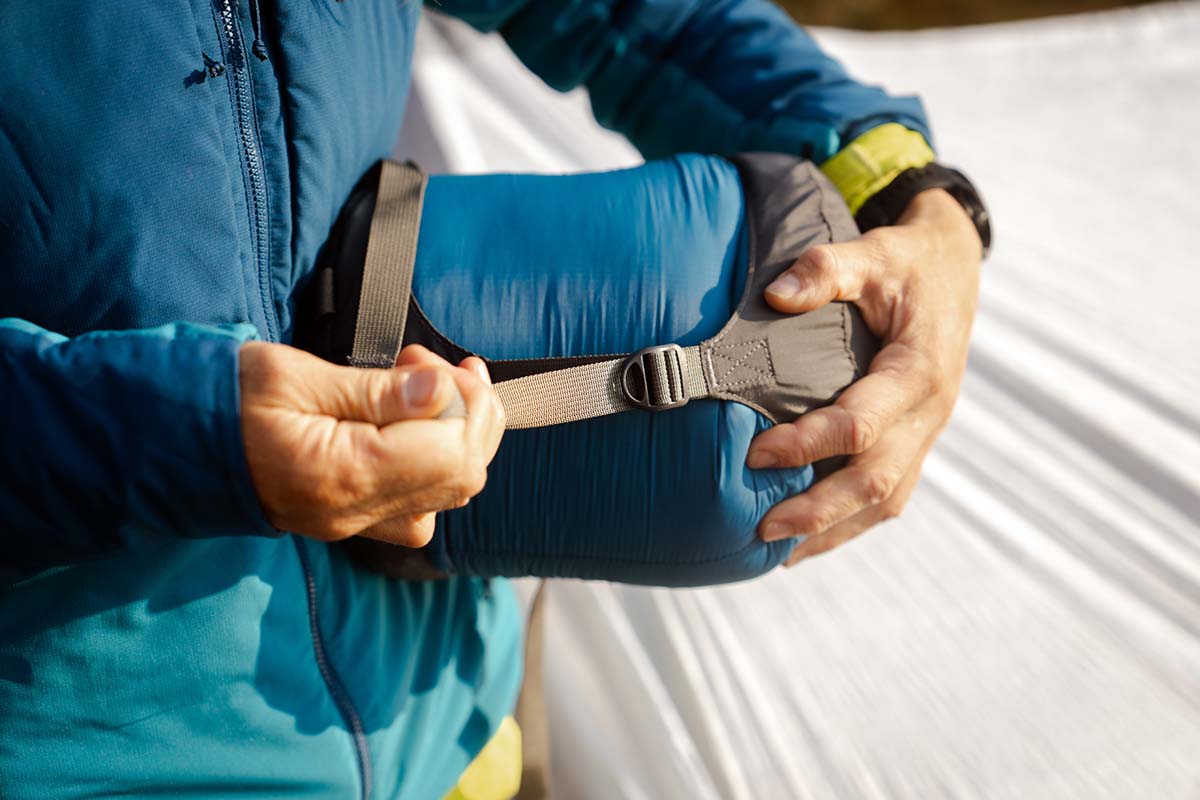
Zipper
It's not very common to see stuff sacks with a zipper closure, but we do include one on our list above: the Hyperlite Stuff Sack Pillow. Unlike other closures, the zipper does not require the stuff sack to cinch together at any point, so the volume can stay consistent throughout. This is a helpful trait if you're using your stuff sack as a pillow, which is why we see a zipper on both Hyperlite's and Zpacks' designs. That said, zippers add weight and bulk and aren't particularly practical for standard stuff-sack use. Finally, as far as protection goes, Hyperlite's pillow keeps things decently weather-ready with a water-resistant zipper, while Zpacks' pillow uses both a watertight zipper and a roll-top closure.
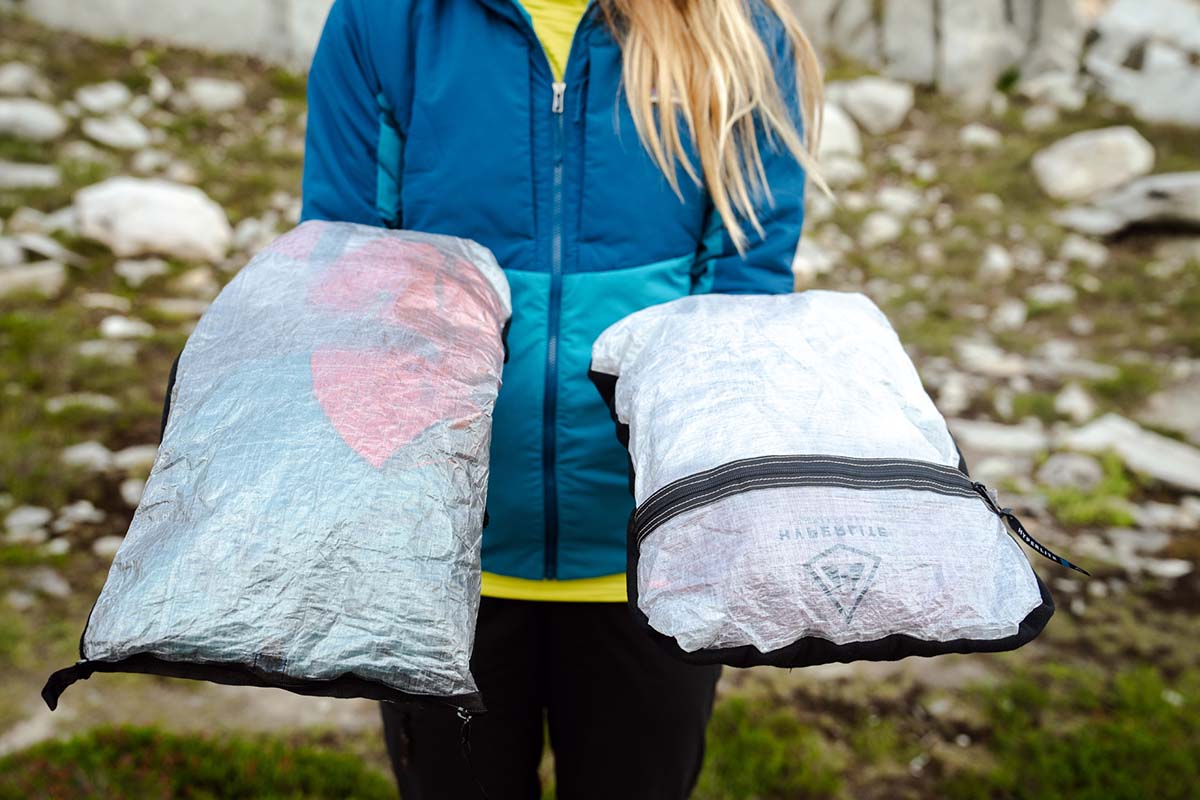
Stuff sacks come in a range of capacities, from less than a liter to 60 liters or more. We’ve found 2- to 3-liter sacks to be the best size for organizing small items like a hygiene kit or backpacking electronics (a small power bank, a few cords, and a headlamp). For clothing and food storage, you’ll want anything from 5 to 10 liters; if you’re hanging food for two or more people, you’ll likely want to bump up to around 15 liters. And for sleeping bag storage, we love Sea to Summit’s 8-liter compression sacks for our ultralight quilts and summer-weight bags, but the 13-liter designs will work best for most standard backpacking sleeping bags.
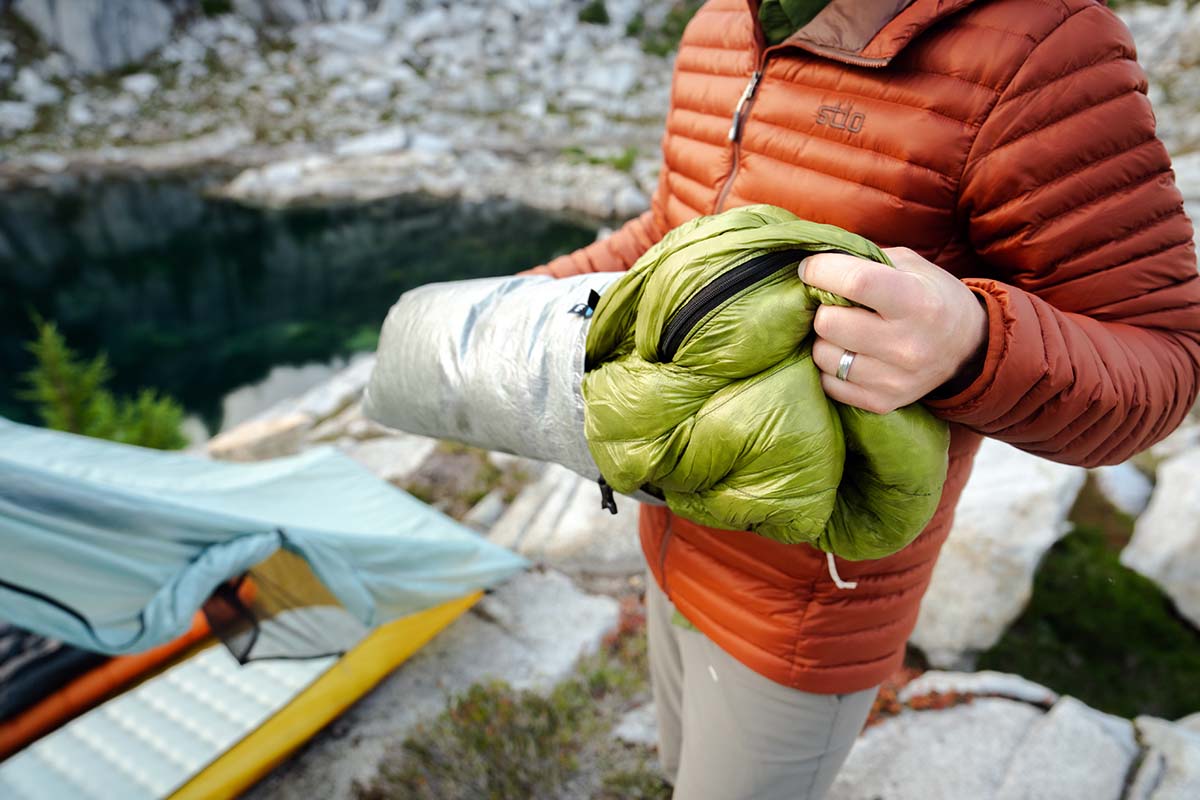
You won’t find many uses for a stuff sack larger than around 15 liters for backpacking, but stuff sacks can also come in handy for paddling, camping, and other outdoor activities—and plenty of applications at home, too. We love the 20-liter Sea to Summit Mesh for year-round sleeping bag storage, for example, and keep our beach items in a similar-capacity sack. Larger dry bags (like the 35-liter Sea to Summit Lightweight Dry Bag) can be a great way to store an overnight kit on a paddling trip, as long as you’re not at too much risk of capsizing. And if you’re looking for a way to store and schlep bulky camping gear without having to deal with rigid boxes, check out a design like REI’s 60-liter Durable Stuff Sack.
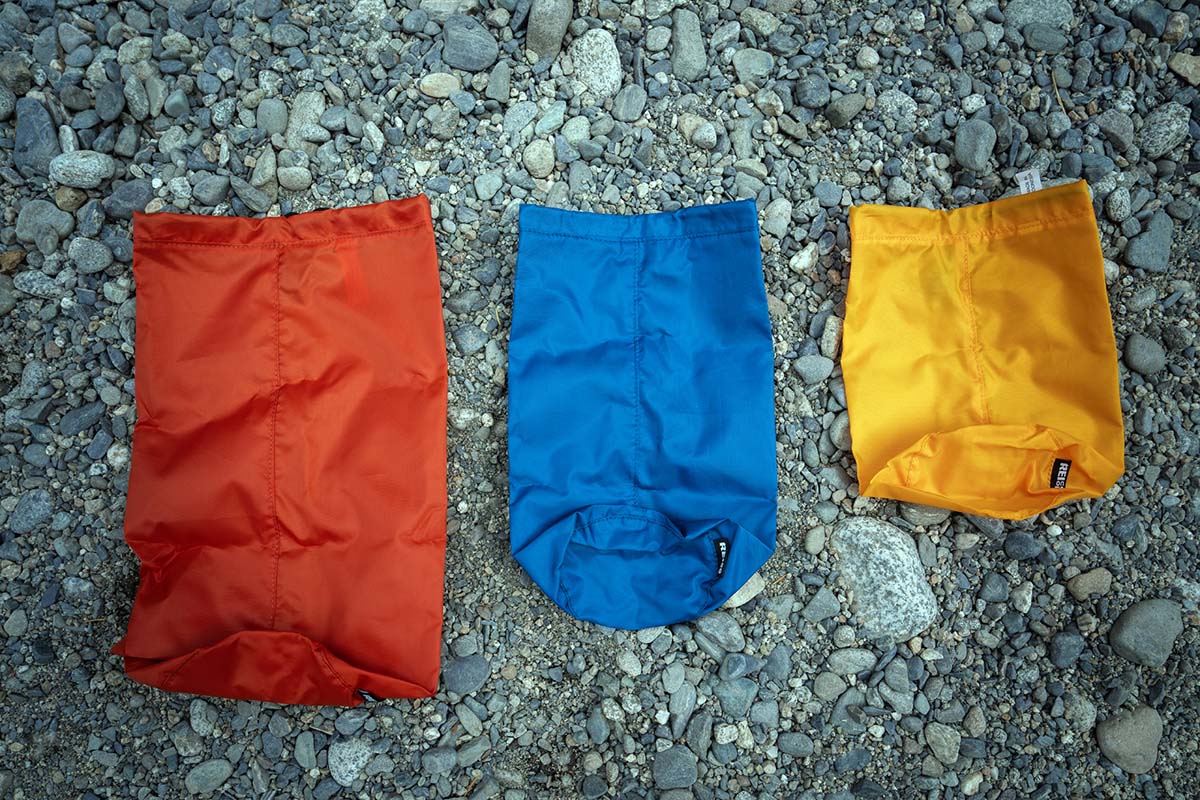
Along with a stuff sack’s capacity, shape is another key consideration. Most stuff sacks are some variation of a cylinder, with a round and flat (or flat-ish) bottom and straight sides. These styles are easy to stuff and thus our top choice for lofty items like a tent, sleeping bag, or down puffy. But manufacturers have gotten creative with their stuff sack shapes, and it’s also common to see flat, rectangular designs (with no base), such as the Hyperlite Drawstring or Hilltop Packs Bear Bag. These designs are less useful for bulky or lofty gear, but we really like them for lower-profile items like dehydrated backpacking meals or a book and journal. Their sleek shape also makes them an ideal fit for stashing in the outside dump pocket of many ultralight backpacking packs.
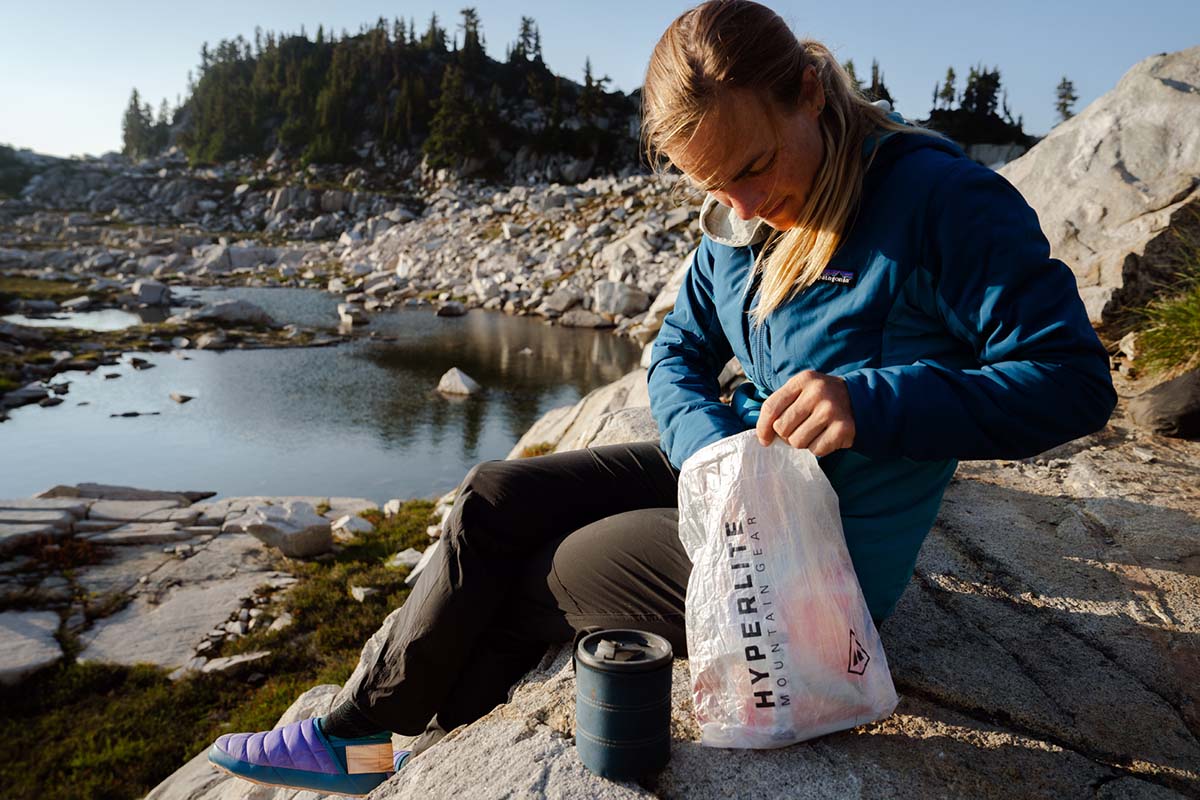
Nylon/Polyester
Most stuff sacks are built with nylon or polyester, but there’s a lot of variation within these two synthetic materials. Nylon is the most common ultralight choice: It’s relatively strong, tear- and puncture-resistant, and packs down pretty well. Most nylon stuff sacks range from about 30- to 70-denier, and thicker varieties are certainly better for use outside of a backpack (the Sea to Summit Big River Dry Bag is 420D, for instance). It’s also common to see silnylon—short for silicone-treated nylon—which is a premium, waterproof blend of the material. Polyester stuff sacks are generally thicker and more affordable than nylon designs (consider the REI Co-op Durable), but some modern blends are highlighted by their impressive durability and low weight (like the Ecopak seen in the Hilltop Packs Bear Bag).
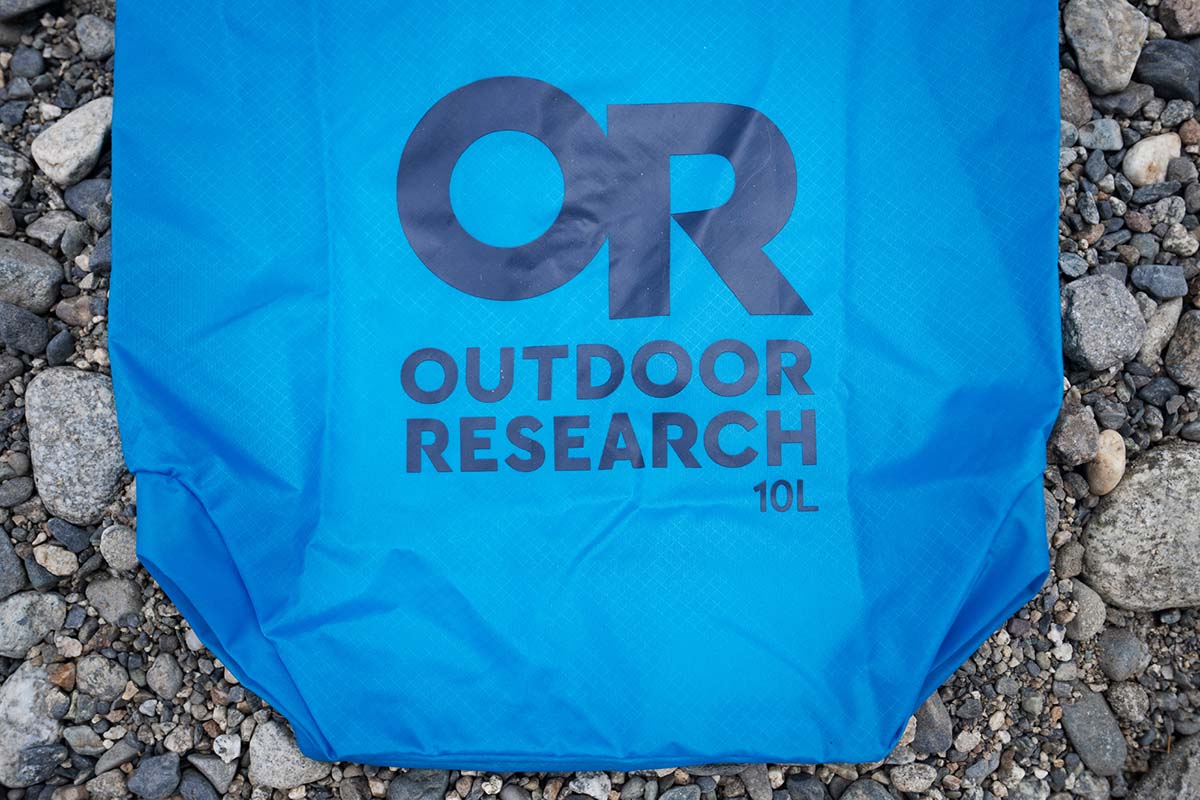
Dyneema
Dyneema Composite Fabric—often referred to as simply Dyneema, or DCF—is the darling of ultralight gear and a fabric that’s lauded for its low weight, high tensile strength, and inherent waterproofing abilities. Unlike nylon and polyester, it doesn’t require waterproof coatings, which provides some added assurance (waterproof coatings can wear off over time) while minimizing weight and bulk. In our experience, Dyneema stuff sacks can be thrown around, used daily, and stored outside of a backpack without worrying too much about the consequences. However, it is worth noting that Dyneema can form holes in between the fibers, which is especially important to keep in mind if you’re relying on your stuff sack’s waterproofing. It's also significantly pricier than synthetic alternatives. But for weight-conscious adventurers who demand a lot from their gear, it’s hard to beat Dyneema’s combination of low weight, waterproofing, and durability.
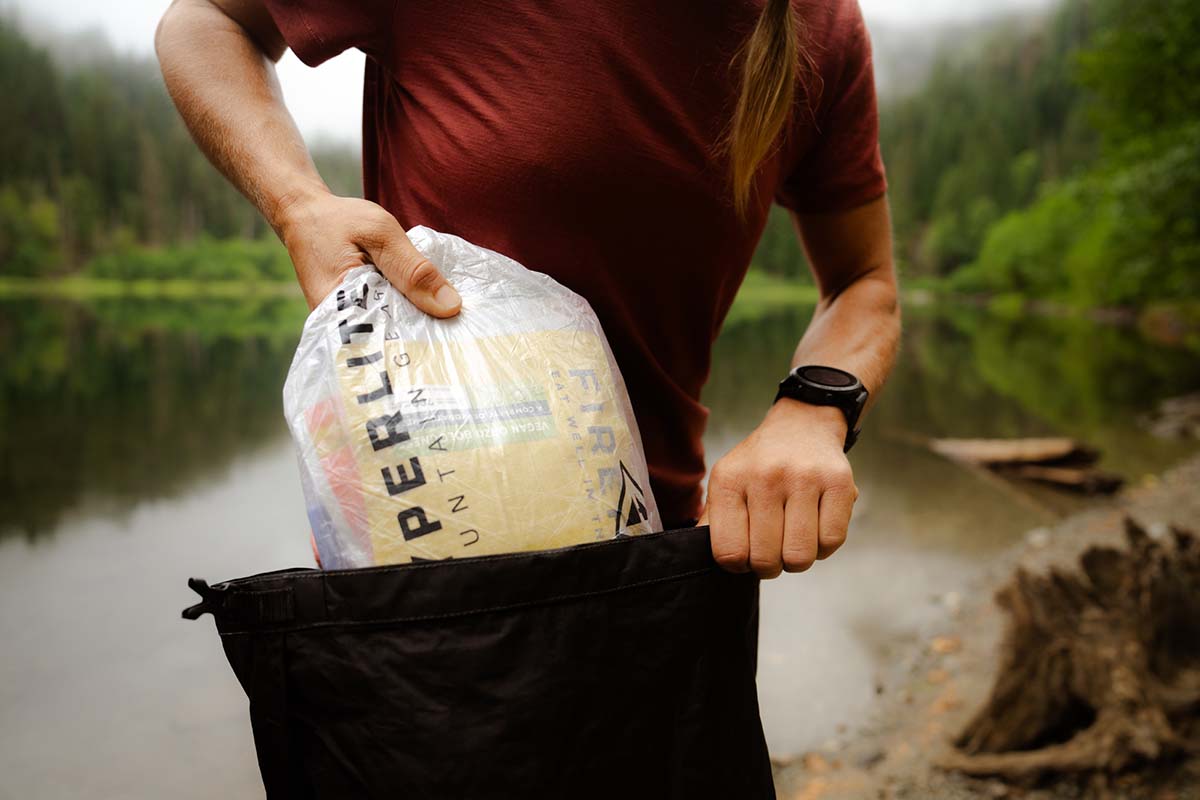
Mesh
Mesh isn’t the most popular stuff sack material, but it certainly comes in handy for the right applications. Unlike synthetic and Dyneema alternatives, mesh stuff sacks can drain water and are highly breathable, which makes them a great choice for storage of wet gear (swimming or snorkeling equipment, for example) or items that need to breathe, such as fresh food or dirty laundry. We also love mesh stuff sacks for long-term sleeping bag storage. Sea to Summit makes our favorite mesh stuff sacks, which come in a range of capacities from 1.5 to 20 liters.
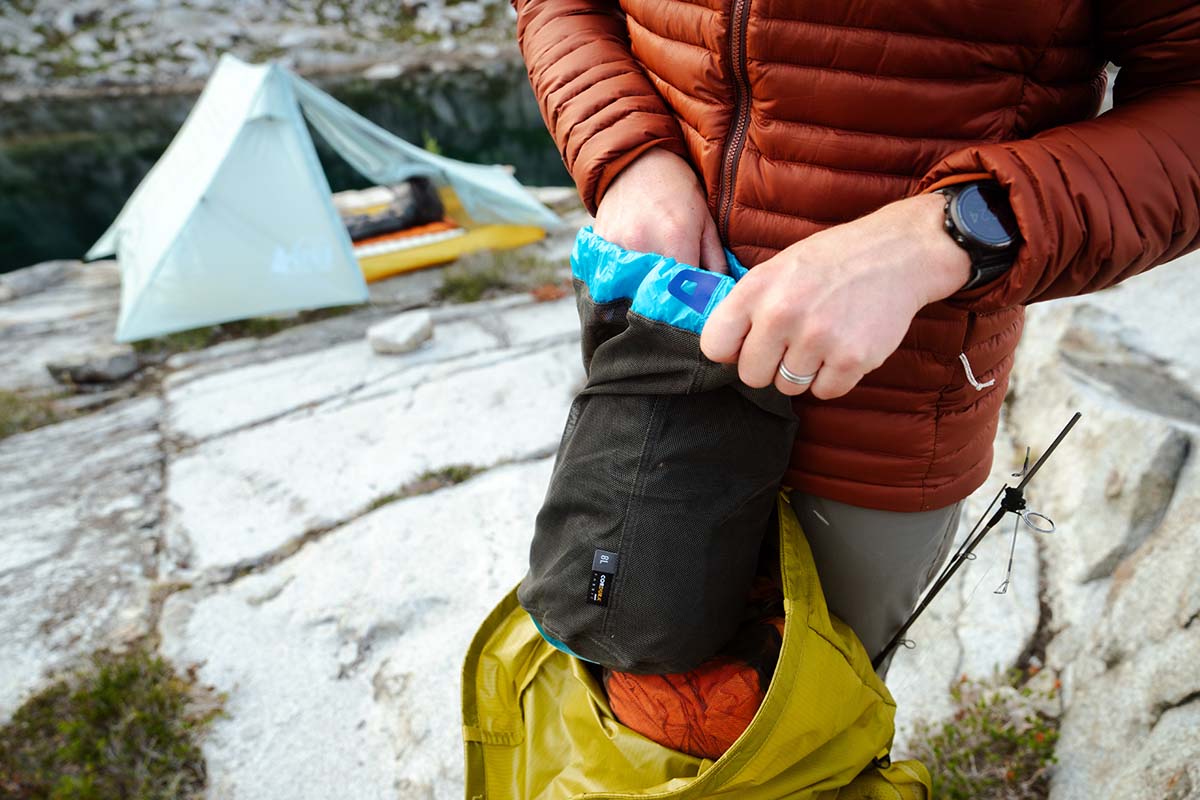
There are a number of factors that help make a stuff sack more water-resistant or fully waterproof. A roll-top closure is the most identifiable feature: While not fully watertight (and therefore not submersible), roll-tops offer a lot more assurance against errant raindrops or splashes than drawstring closures. Next up is the stuff sack’s fabric. Dyneema is inherently waterproof, while nylon and polyester use coatings to keep water at bay—the most common of which are silicone, polyurethane (PU), and polyethylene (PE). Silicone-treated nylon (or silnylon) is the most lightweight and durable option (seen in the premium Sea to Summit Ultra-Sil collection), while we often see PU/PE used on the inside of stuff sacks. Most designs utilize one or both of these treatments and tack on a durable water repellent (DWR) finish to the outside, which prompts moisture to bead up and roll off the exterior rather than soak through.
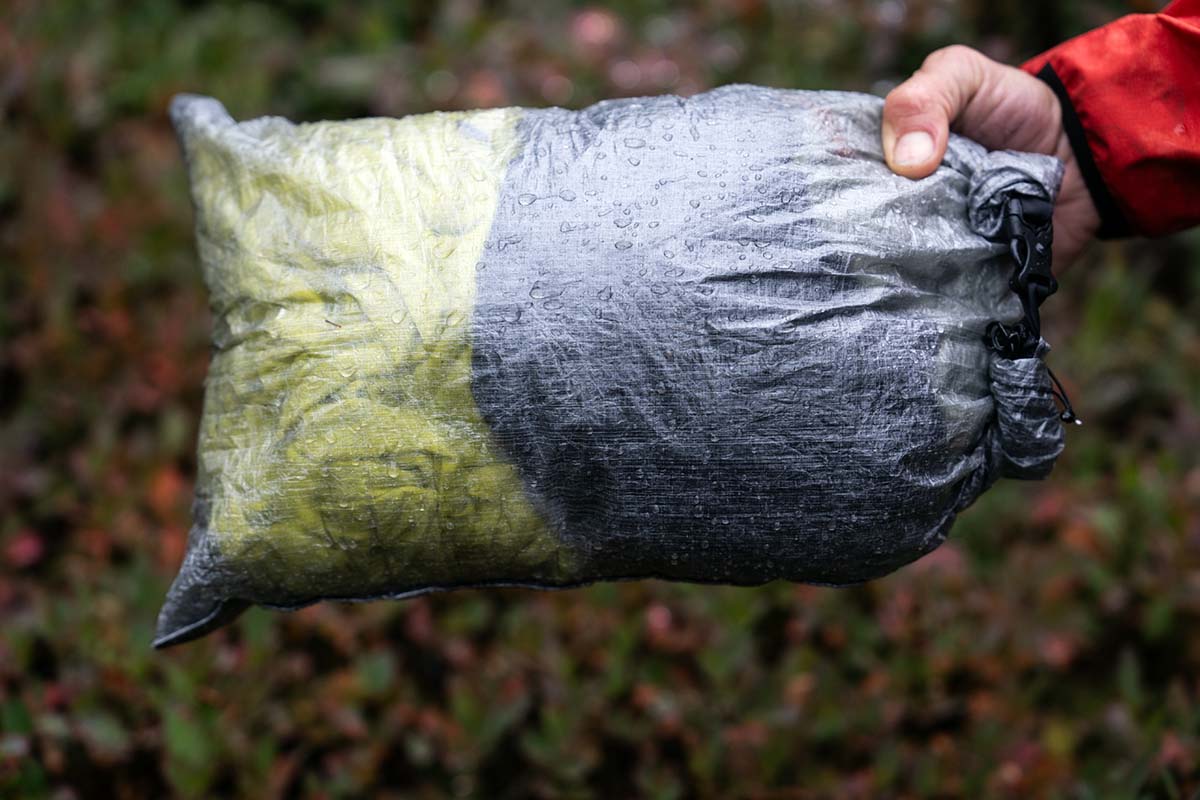
Finally, in order to be considered watertight, a stuff sack’s seams must also be taped. Taken together, waterproof stuff sacks are those that use a roll-top closure, waterproof fabric(s), and taped seams, such as the Hyperlite Roll-Top or Sea to Summit Lightweight Dry Bag. In contrast, Sea to Summit’s drawstring offerings (like the Lightweight Stuff Sack) feature coatings for water resistance but forgo taped seams and watertight closures.
Stuff sacks are fairly simple pieces of gear, but there are a few noteworthy features to look out for. Many designs have a webbing handle at the base, which can be particularly helpful for pulling the stuff sack from your tightly packed backpack or toting it around camp. On the topic of toting, Sea to Summit adds a few attachment points to some of their dry bags (the Lightweight, Big River, and Evac) for compatibility with their Dry Bag Sling, which converts your bag into a convenient over-the-shoulder tote. Finally, we’ll often see stuff sacks with a small webbing loop (separate from the drawstring), which is a great addition if you plan to hang your bag from a tree or lash it to a backpack, boat, or bike.
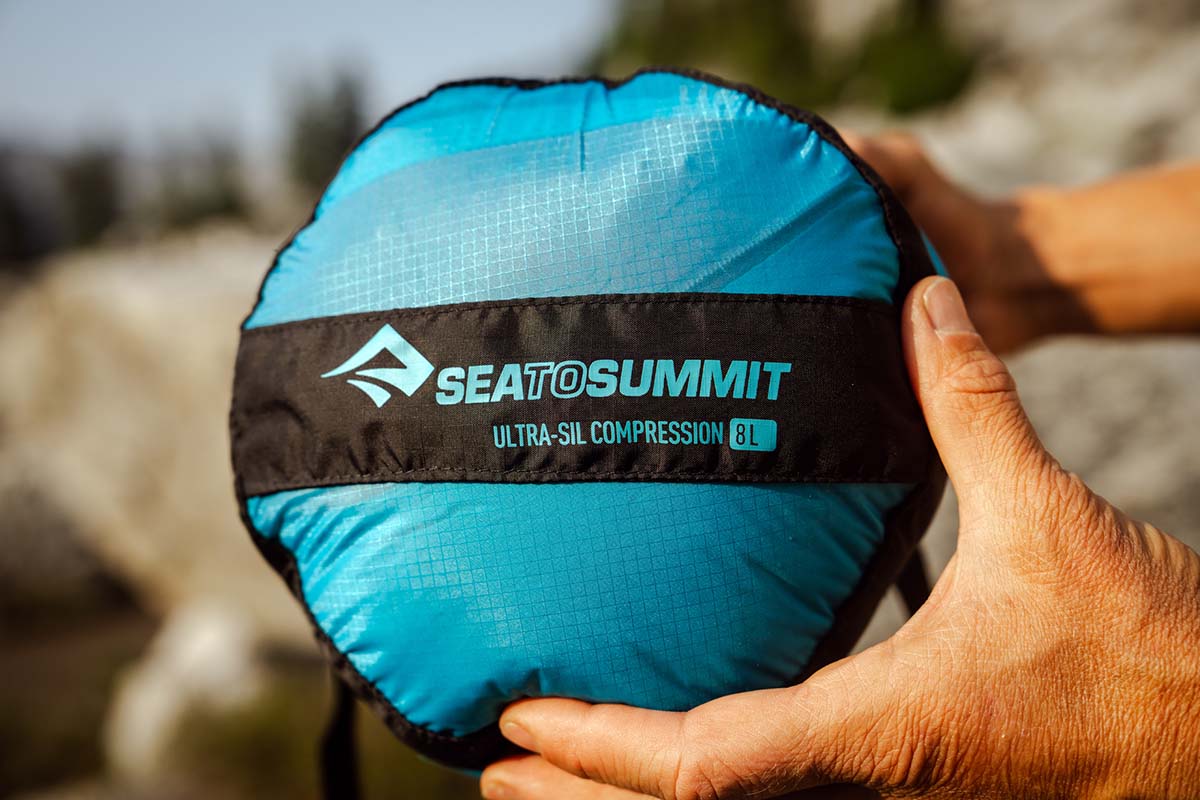
Stuff sacks are minimalist pieces of gear to begin with, so only the most weight-conscious of adventurers will be considering their heft. But if you’re counting ounces, there are slight variations worth mentioning. In an effort to help with comparisons, we’ve listed the weight of each sack for its 8- to 11-liter capacity (when available) in our table above, which range from a scant 0.3 ounces for the 8.5-liter Zpacks Stuff Sack to 4.4 ounces for the 10-liter SealLine Blocker Compression Dry Sack.
The weight of a stuff sack correlates closely with its materials and style. In general, polyester stuff sacks are the heaviest, followed by durable nylon designs. Ultralight nylon stuff sacks (like Sea to Summit’s Ultra-Sil Stuff Sack) are among the most lightweight, topped only by Dyneema offerings like those from Zpacks and Hyperlite. In terms of style, drawstring varieties keep weight the lowest (consider the 0.3-oz. Zpacks), followed by roll-top designs, and then compression sacks (waterproof compression sacks like the SealLine Blocker and Sea to Summit Evac are among the heaviest options).
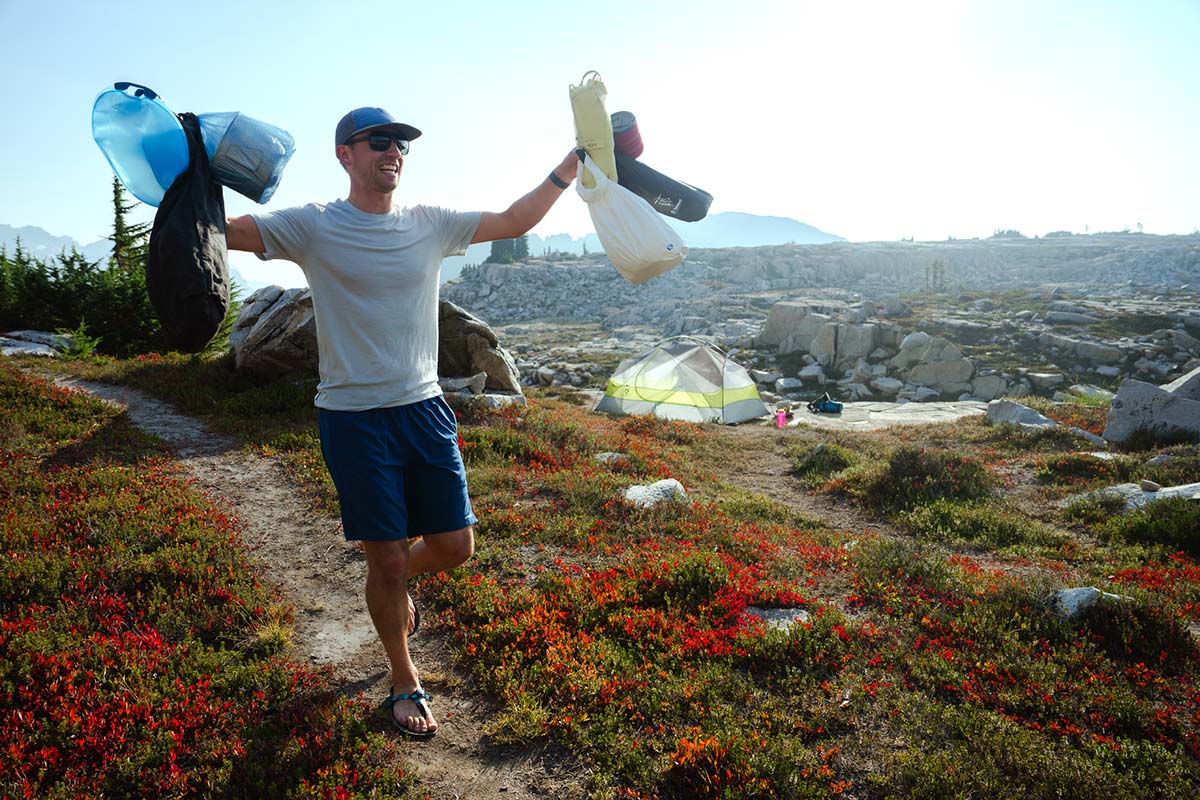
If you’re traveling in bear country, you’ll want to have a solid plan for storing your food. Hanging all of your scented items is one solution (we recommend a decently durable stuff sack), but some wilderness areas require additional precautions. A rigid bear canister is the most common recommendation (these are typically available for rent at Forest Service offices or ranger stations), but some areas also permit the use of bear-resistant Ursack bags. Made with thick UHMWP fabric (a generic name for Dyneema), these bags are incredibly strong and built to resist tearing, even when subjected to the claws and teeth of a bear.
Ursack bags are a lightweight and space-saving solution to bear-proofing your food, but you’ll want to make sure you follow the directions to a tee. Just like storing your food in a stuff sack, you’ll need to close the Ursack securely and hang it high in a tree away from camp. Of course, no food-storage solution is truly bear-proof, but the Ursack does offer a step up from a standard stuff sack. Ursack’s Major series comes in three sizes ranging from 10.7 to 30 liters, and they also make their more durable (and critter-resistant) Ursack AllMitey in 10.7-, 20-, and 30-liter capacities.
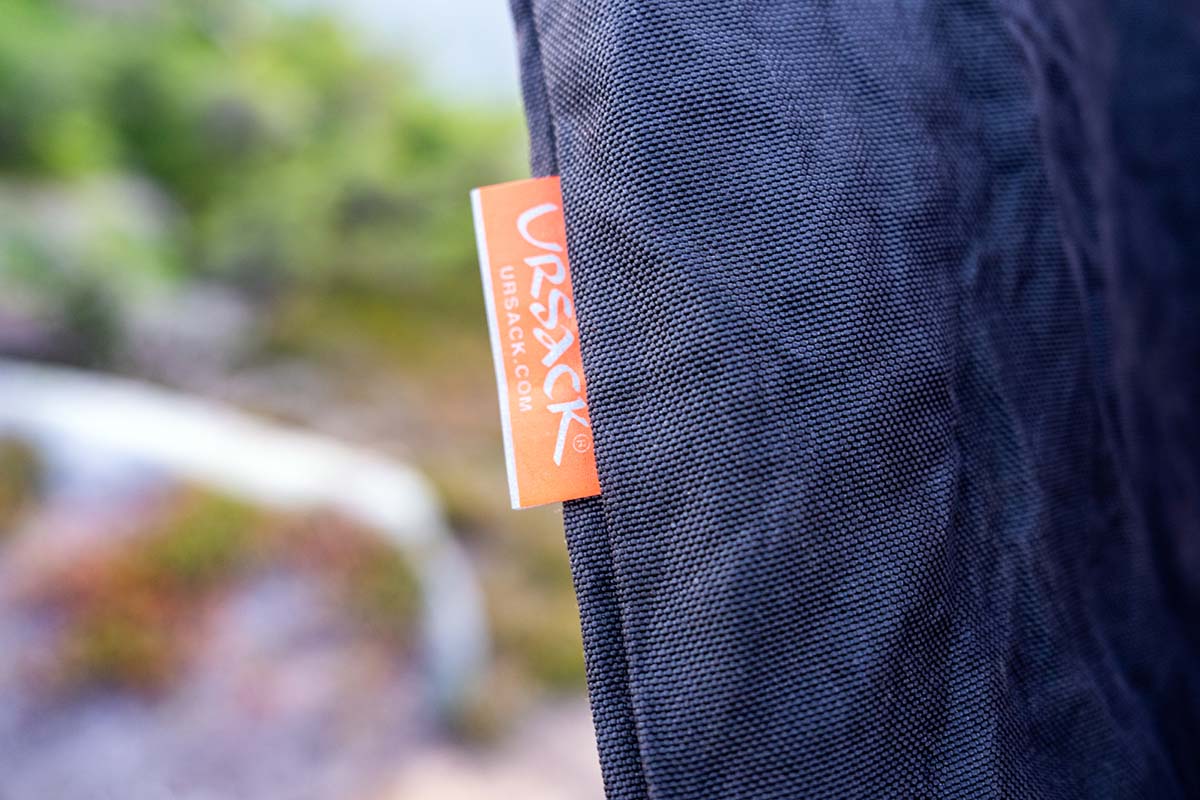
Sustainable production practices have grown increasingly common in recent years, starting with the use of recycled fabrics. In the case of stuff sacks, we see companies like Sea to Summit, REI Co-op, and Hilltop Packs stepping up to prioritize these materials in their designs. A number of stuff sacks are also being made from upcycled or repurposed fabrics—Blackstrap is a great example of this trend, and Osprey also offers their Remnants Stuff Sacks. Finally, some manufacturers have started using PFC-free durable water repellent (DWR) coatings, which forgo the use of per- or polyfluorinated chemicals—"forever chemicals" known to be harmful to the environment and under scrutiny in many states. It’s worth noting that most Dyneema products do not contain recycled materials, although they don't require chemical-based waterproof treatments and are built to last (thus keeping them out of the landfill).
Stuff sacks are the age-old classic for staying organized in the backcountry, but there are a number of other compelling alternatives. Many brands now make lightweight packing cubes, which come in a range of capacities and feature zippers for convenient access. Packing cubes aren’t as streamlined as stuff sacks, and there aren’t as many true backpacking options (most are designed for travel), but Hyperlite’s Pods are unsurprisingly lightweight (the 9L version is 1.2 oz.) and functional for backcountry use. Granite Gear also offers their Zippsack, which uses durable 210-denier nylon and is available in four sizes from 8 to 25 liters.
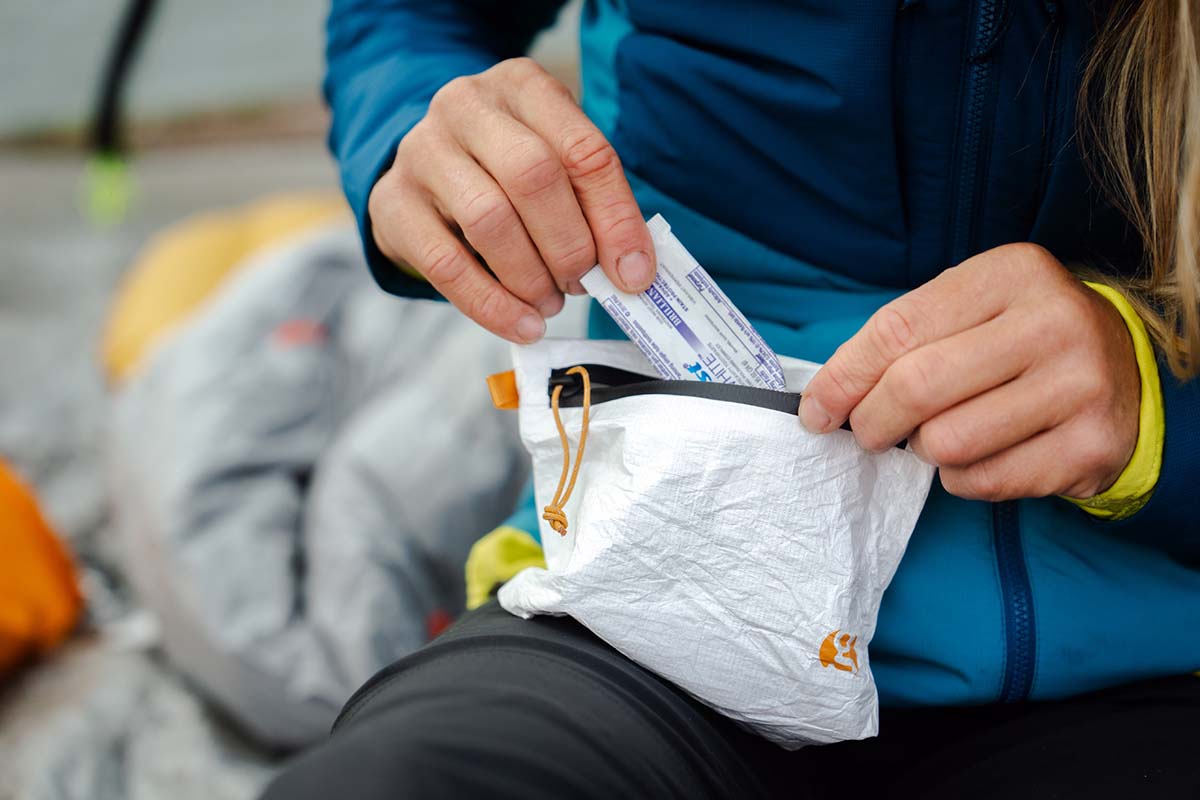
Finally, while more of a pouch than a packing cube, we love Gossamer Gear’s Storage Sacks, which boast watertight zippers and coated Tyvek for secure yet lightweight storage (the Ditty Small makes for a great backcountry wallet).
Back to Our Stuff Sack Picks Back to Our Stuff Sack Comparison Table